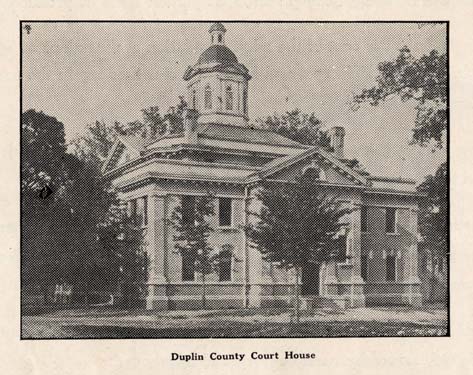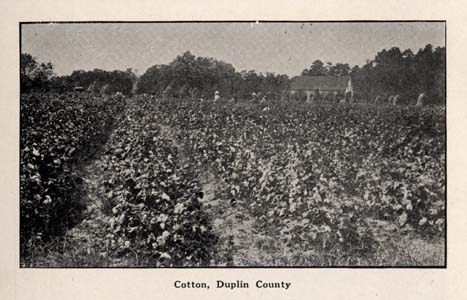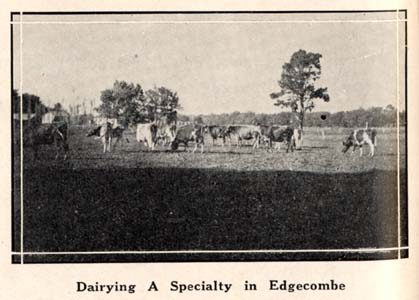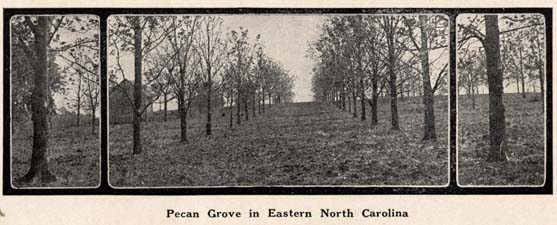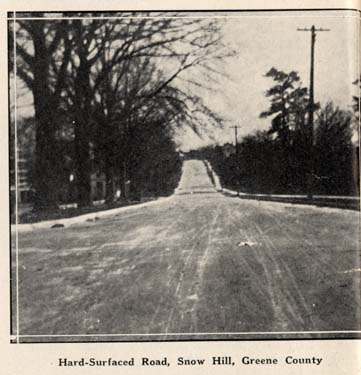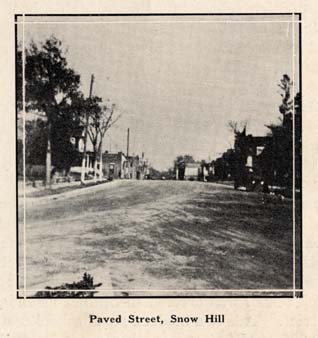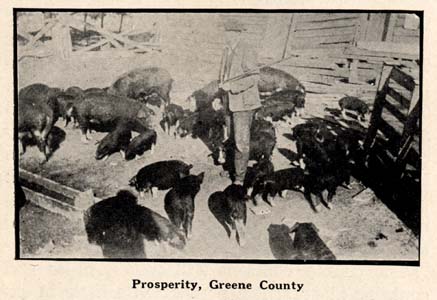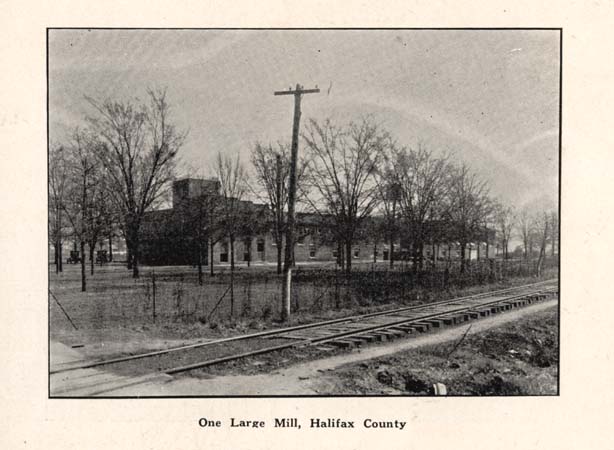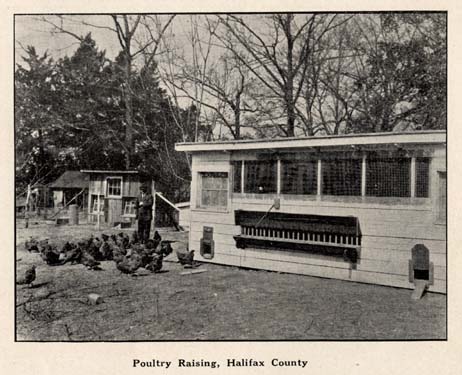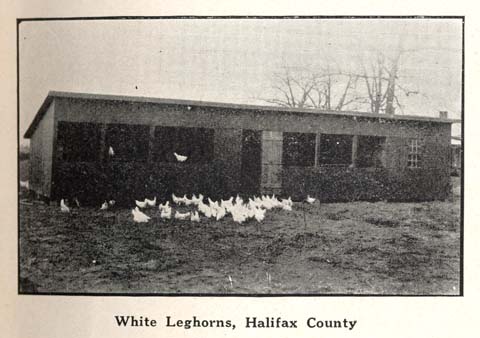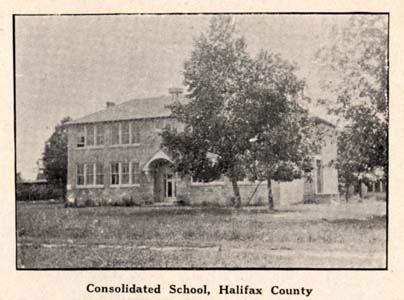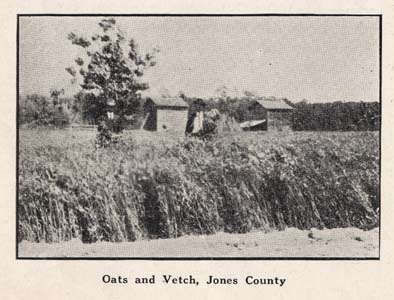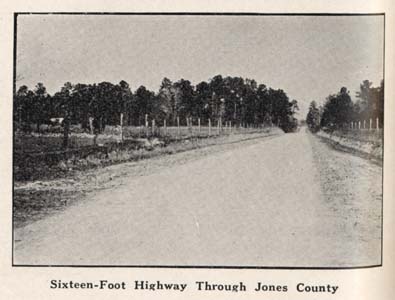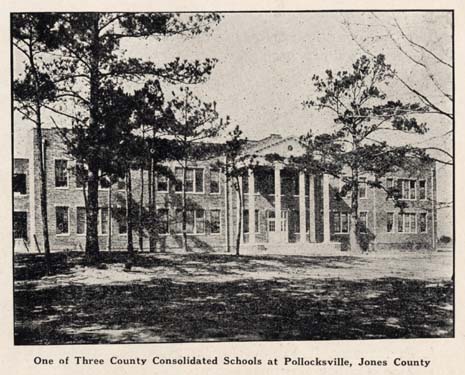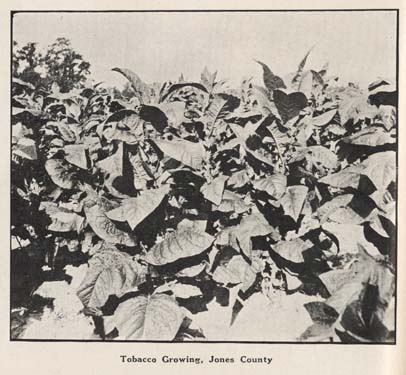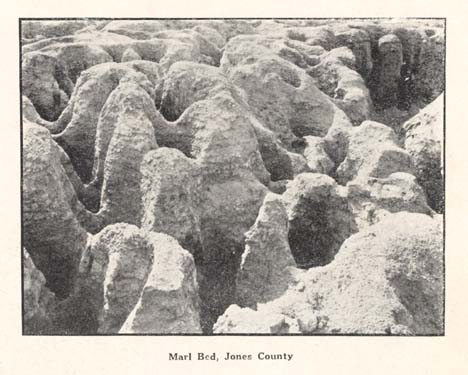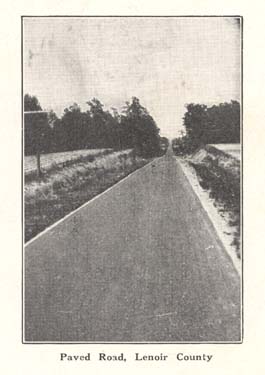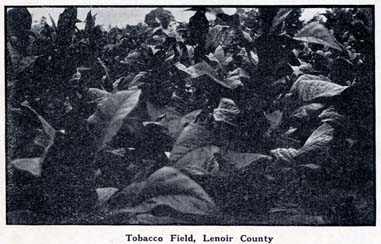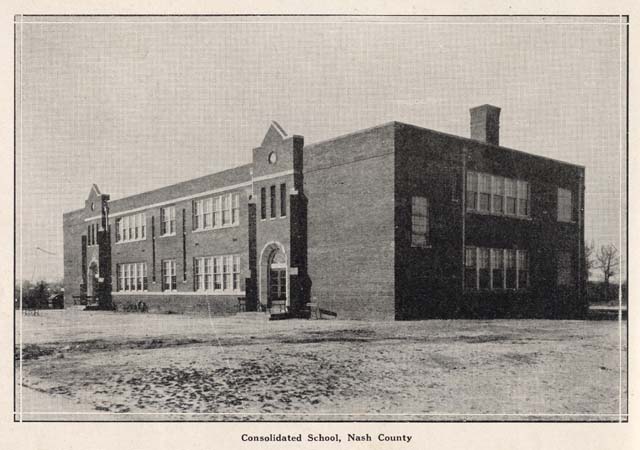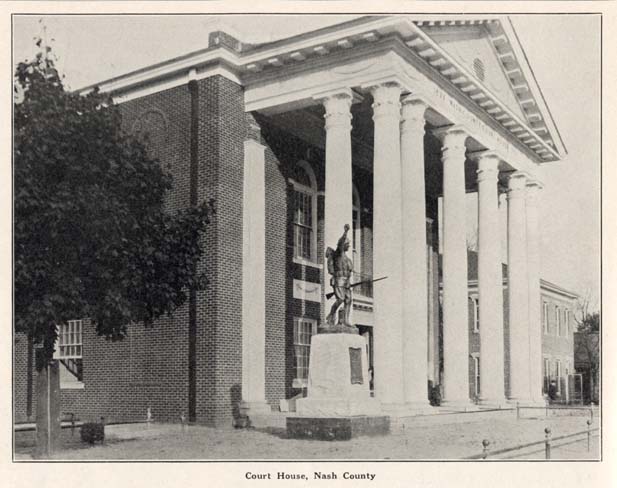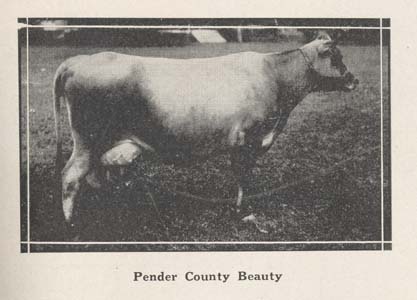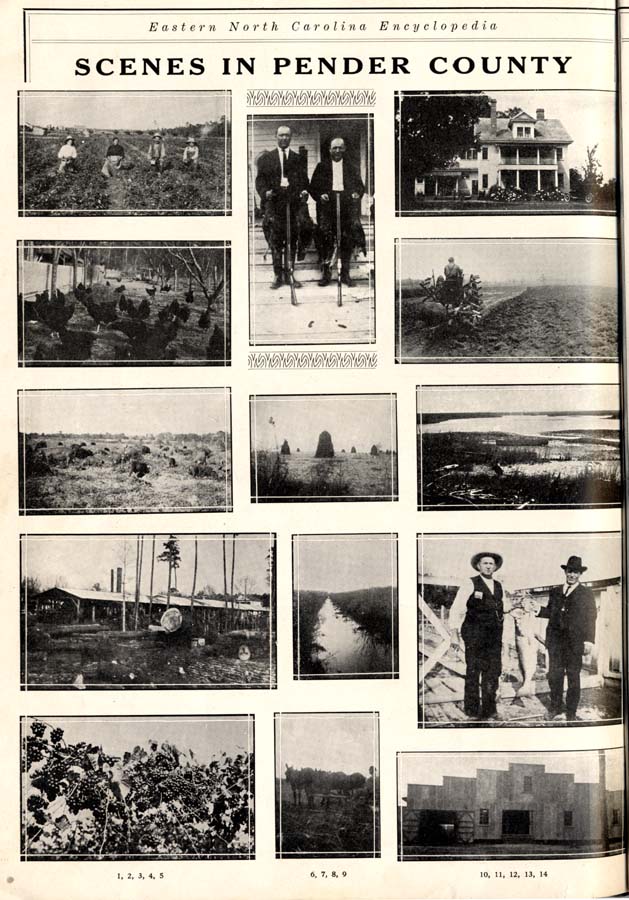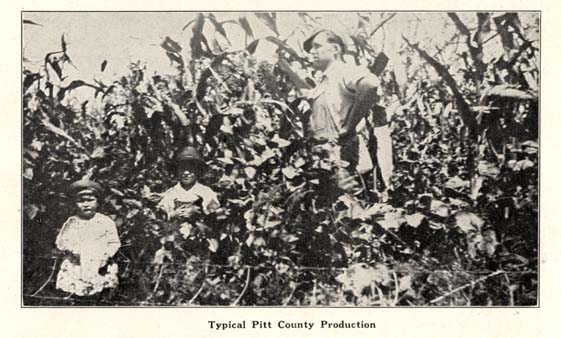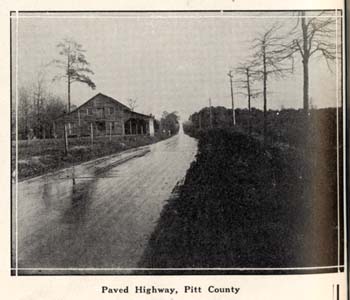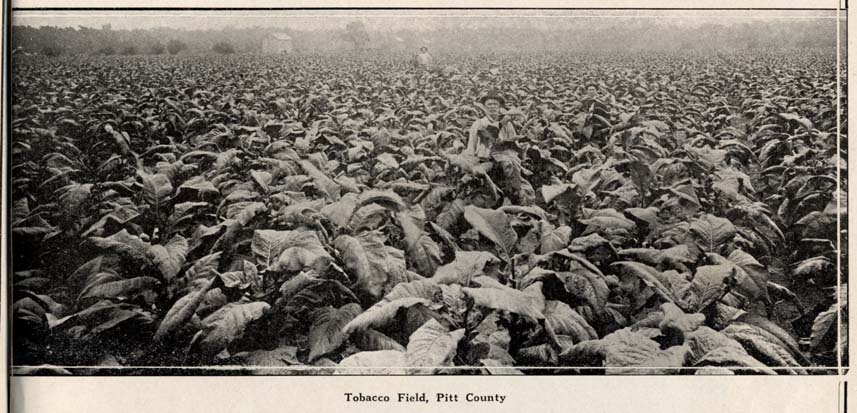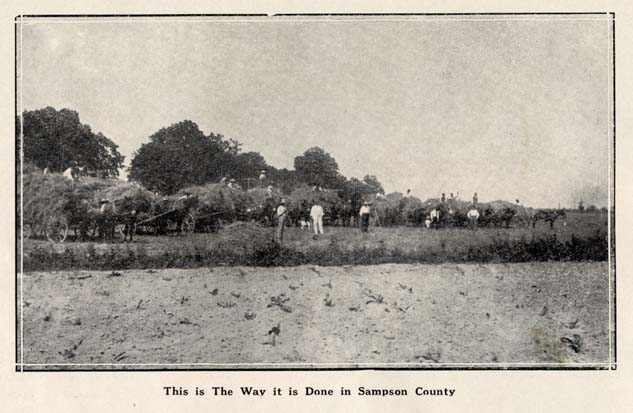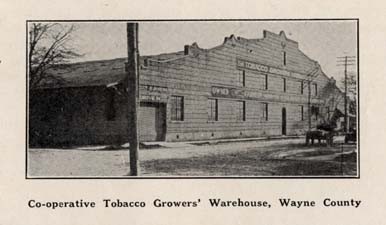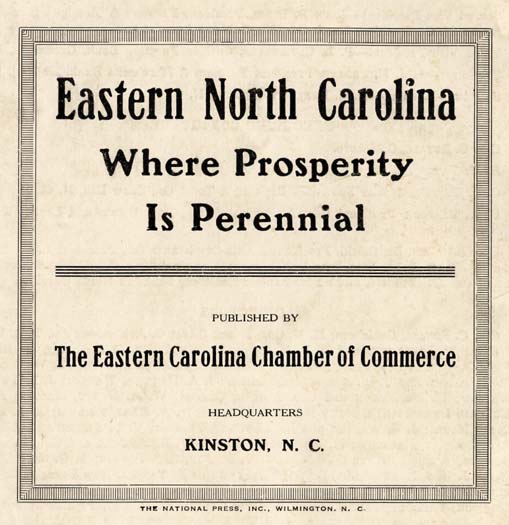Eastern North Carolina, Where Prosperity is Perennial, Invites You!:
Electronic Edition.
Eastern Carolina Chamber of Commerce (Kinston, N.C.)
Funding from the Institute for Museum and Library Services supported the electronic publication of this title.
Text transcribed by
Apex Data Services, Inc.
Images scanned by
Melissa Meeks
Text encoded by
Apex Data Services, Inc., Andrew Leiter, and Melissa Meeks
First edition, 2002
ca. 150 K
Academic Affairs Library, UNC-CH
University of North Carolina at Chapel Hill,
2002.
Source Description:
(cover) Eastern North Carolina, Where Prosperity is Perennial, Invites You!
(running title) Eastern North Carolina Encyclopedia
(alternative title) Eastern North Carolina Invites You!
(alternative title) Eastern N.C. Invites You!
(alternative title) Encyclopedia of Eastern North Carolina
(alternative title) Eastern N.C. Encyclopedia
Eastern Carolina Chamber of Commerce (Kinston, N.C.)
49 p., ill.
Kinston, N.C.
Eastern Carolina Chamber of Commerce
[1924?]
Call number Cp917 E13e c.3 (North Carolina Collection, University of North Carolina at Chapel Hill)
The electronic edition is a part of the UNC-CH
digitization project, Documenting the American South.
The text has been entered using double-keying and verified against the original.
The text has been encoded using the
recommendations for Level 4 of the TEI in Libraries Guidelines.
Original grammar, punctuation, and spelling have been preserved. Encountered typographical errors have been preserved, and appear in red type.
Any hyphens occurring in line breaks have been
removed, and the trailing part of a word has been joined to
the preceding line.
All quotation marks, em dashes and ampersand have been transcribed as
entity references.
All double right and left quotation marks are encoded as " and "
respectively.
All single right and left quotation marks are encoded as ' and ' respectively.
All em dashes are encoded as --
Indentation in lines has not been preserved.
Running title, "Eastern North Carolina Encyclopedia", has not been preserved.
Spell-check and verification made against printed text using Author/Editor (SoftQuad) and Microsoft Word spell check programs.
Library of Congress Subject Headings
Languages Used:
- English
LC Subject Headings:
- North Carolina -- Description and travel.
- Agriculture -- North Carolina.
- Industries -- North Carolina.
- North Carolina -- Economic conditions.
- Industrial promotion -- North Carolina.
- Cities and towns -- North Carolina.
- City promotion -- North Carolina.
Revision History:
- 2003-03-13,
Celine Noel and Wanda Gunther
revised TEIHeader and created catalog record for the electronic edition.
-
2002-12-20,
Melissa Meeks
finished TEI-conformant encoding and final proofing.
-
2001-12-06,
Andrew Leiter
finished TEI/SGML encoding
- 2001-11-20,
Apex Data Services, Inc.
finished transcribing the text.
[Cover Page Image]
Eastern North Carolina
Where Prosperity is Perennial
INVITES YOU!
Page 1
PREFACE
IN PRESENTING to the reader this "Encyclopedia" of Eastern North Carolina, we wish to emphasize the fact that the information contained herein about any county, is authentic. These facts of the various counties participating, have been carefully gone over by the Eastern Carolina Chamber of Commerce officials to be sure that no extravagant statements have been made.
This organization, which has for its territory 46 counties in Eastern North Carolina, felt that a publication such as this, where the information could be regarded as authentic, is necessary. There are so many "facts" issued about different sections that have no substantial backing, the would-be-citizen becomes disgusted and is inclined not to believe any of them. But you may be assured that you are dealing with a reputable organization and that nothing will be misrepresented in these pages. We invite you to investigate the possibilities of Eastern North Carolina, "Where Prosperity is Perennial."
For further information about any part of Eastern North Carolina, please write,
EASTERN CAROLINA CHAMBER OF COMMERCE,
Headquarters: Kinston, N. C.
Page 2
North Carolina to the Front Rank
Although this publication deals primarily with conditions in Eastern North Carolina, it might be well to give a few facts about the State as a whole. The counties listed in this publication have made it possible and although the territory covered by this organization includes 46 counties, only those making appropriations for this special work are included in this book. However, the Eastern Carolina Chamber of Commerce will be delighted to furnish information about any of the counties of the 46.
No state in the Union has made such rapid increase industrially, agriculturally, and educationally as North Carolina, during the recent years. Her growth sounds more like a fairy tale than it does real facts. But it is a fact just the same. In 1900 expenditures for education in North Carolina amounted to less than a million; in 1923 the expenditures total $23,000,000.00. In 1900 the expenditure for new school buildings was less than $41,000.00; in 1922 it was more than $6,000,000.00. In 1900 the average value of each school house was $150.00; in 1922 it was $4,500.00. In 1900 the average length of public school term was 73 days; in 1922 it was 143 days. In 1900 North Carolina had about 30 high schools; in 1923 she had 475. In 1900 the percentage of illiteracy in North Carolina was 29.4; in 1920 it had been reduced to 13.1, the white race being only 7.1.
MANUFACTURING
In 1900 the capital invested in manufacturing in North Carolina was $68,283,000.00; in 1920 it was $669,144,000.00. In 1900 the value of manufactured products was $85,274,000.00; in 1920, $943,808,000.00. In 1900 North Carolina cotton mills used 190,000,000 pounds of cotton; in 1920, 449,000,000 pounds. In 1900 North Carolina produced 29,790,000 bushels of corn; in 1920, 54,630,000 bushels.
FINANCES
These figures speak for themselves. In 1900 the total resources of the National Banks of North Carolina was $15,362,000.00; in 1920, $183,816,000.00. In 1900 the total deposits in National Banks in the State were $16,700,000.00; in 1920 they were $315,000,000.00. In 1900 the assessed valuation of property in the State was $306,579,000.00; in 1920 it was $3,139,705,000.00.
EASTERN NORTH CAROLINA HAS HER SHARE
Our territory covers half the State and the enormous figures referred to above apply half to Eastern Carolina and half to the other part of the State. No section of the State has made greater progress along any line than the Eastern Part of the State and we take great pride in submitting figures to anybody interested in determining any of the above facts relating to this section.
Page 3
BERTIE COUNTY
The home-seeker and investor will find in Bertie County, a pleasant land, a hospitable people, a productive soil, a low valuation of property, and a low tax rate; good schools, convenient churches, and a warm welcome.
Its population is homogeneous and law-abiding. The feeling between the races is friendly and cordial. We have nearly a half million acres of land, and around twenty-five thousand people. We have room for all who wish to better themselves.
The Bankhead National Highway passes north and south through the county; and the county has a well organized road system and force. The surface of the county is gently rolling, to rolling. Its highest point above the sea level is 97 feet. All of the lands are capable of drainage. A dozen rivers, creeks and swamps furnish an outlet for water.
According to Weather Bureau reports the mean annual temperature is 60.3 F. The winter mean is 42.5, and the summer mean is 77.5. The date of the last killing frost in the spring is April 26th, and that of the earliest in the fall, October 12th. The average date of the last killing frost in the spring is April 1st, and that of the first in the fall, November 1st. This gives an average growing season of 214 days, amply sufficient for maturing all farm and garden crops. There is an ample average rainfall of 50.93. The rainfall is well distributed, the heaviest in the summer and the lightest in the fall. The lands are wonderfully fertile and adapted to any crops raised on the
Page 4
Atlantic Coastal Plain. There are twenty-one soil types in the county in addition to the swamps and pocosins. The main crops raised are cotton, peanuts, tobacco, corn and vegetables. The per acre production of these crops is largely above the average.
The Roanoke River on the west, the Chowan River on the east, and the Cashie River in the center furnish cheap water transportation. Railroad transportation serves the northern and western parts of the county.
The forests of the county have been cut over, but the soil is naturally timber bearing and reforesting is very rapid. Pine, cypress, ash, maple, oak and gum are the predominating commercial woods.
The population of Bertie County is agricultural and rural. There are a half dozen localities where the establishment of a factory of any character would enlist intelligent labor and not disturb the farm work by withdrawal of such persons from the farm. Large families are the rule in the county.
The county is splendidly adapted to the raising of large sheep, cattle and poultry. The cut-over lands and the pocosins and semi-swamps afford bountiful grazing on grass and young reeds.
The waters within the county and bordering on it are full of both food and sport fish. The herring, shad, perch, and rock of the Albemarle section are justly famed for their excellence and food supply. Bertie County borders on the head of Albemarle Sound and these edible fish reach perfection here. The canning of fish roe is an inviting field for profitable investment.
Page 5
Game is abundant and consists of deer, wild turkeys, quail, squirrel, wild ducks and other game birds. Hook and line fishing is an inviting sport.
Berries and nuts grow here in abundance, especially strawberries and pecans. English walnuts thrive well.
There are fine areas for colonization. The cut-over "piney woods" section can be bought cheap and made garden spots of productivity.
Ninety-three per cent of the adult population are members of some church. Baptist, Episcopal and Methodist churches are in the towns and scattered about the county.
The county has a number of good country schools and is determined to give its youth every educational advantage.
Bertie County employs a whole-time health officer. The health of the people is generally good, and the citizenship is robust, energetic and thrifty.
Public roads reach all sections of the county, and the whole population is well served by rural delivery and telephone.
The population of the county descended from Scotch-Irish and English ancestry. There is no foreign population.
The southern practice of hospitality still abides. The stranger within our gates is made to feel at home by our whole-hearted welcome of "howdy, come in."
S. W. KENNEY,
Register of Deeds.
Page 6
Economic Resources of Duplin County
Duplin County, situated in the southeastern part of the State of North Carolina, has an ideal climate for farming. The population is, therefore, for the most part, rural, and of the purest American stock. This rural population is educating its children with modern means and methods, always steadfastly clinging to
Duplin County Court House
the curricula which will make for men and women trained both for citizenship and life. Of the 483,306 acres of land, there is a great portion that is offered for development, and the new vitality and knowledge of the new-comer is welcome.
FARMING
Duplin County contains some of the best farming lands in the United States, and the second best in the South. 65,100 acres are cultivated by farm owners; 41,788 by tenants. Tobacco, cotton and truck crops are grown in greater abundance than any other. There are over 11,000 acres well suited to the production of cotton. In 1920, an average of 275 pounds of lint cotton was produced per acre. In 1920, there were 52,720 acres of corn, which produced on an average of 19 bushels an acre. The southern end of the county is well suited for the growing of tobacco, cotton, corn, and berries. The northern end is suited to the growing of cotton, corn, Irish and sweet potatoes, melons, berries, and cucumbers. In 1920, the bright leaf tobacco produced in Duplin County sold for approximately six and a half million dollars.
The largest shipping point for tuberoses and Magnolia bulbs in the world is at Magnolia. The largest cucumber market in the world is at Calypso.
There are 304,989 acres of wooded land, 6,083 acres improved pasture lands, 106,850 acres cultivated lands, and 23,267 acres of land
Page 7
cleared and easy to cultivate, BUT AT PRESENT LYING OUT IDLE.
MANUFACTURING
Though agriculture is the principal occupation,
Cotton, Duplin County
the manufacture of lumber, doors, sash, and fruit and vegetable packages, both for home and foreign use, has assumed considerable proportions. The recent extension of the Tidewater Power Company's power linesIrish Potatoes, Duplin County
through the county opens up new possibilities in this field. With this power in the cotton producing centers, the manufacture of cotton and cotton seed products will be an ideal industry for this section. The use of Tidewater power is considered cheaper than the use steam in manufacturing in this county.
WEALTH
The census property valuation of the county in 1919 was $32,500,000; crop production, $20,000,000; per capita wealth, $1,080; per capita farm production, $665. The bank resources are approximately $3,800,000. They are in Duplin County ideal opportunities for opening up new fields of wealth, namely, the manufacture of cotton, cotton seed product and lumber. Electric power is available in the centers where these raw materials are produced at reasonable rates.
Page 8
POPULATION
The increase in population from 1910 to 1920 was 18.8 per cent, 2.9 per cent higher than the average rate for North Carolina, and 3.9 per cent higher than the average rate for the United States.
The population, according to the 1920 census, was 30,223. The majority of inhabitants are of pure American stock, whose predecessors
Train Load of Cucumbers and Strawberries Headed North--Duplin County
were Irish, Scotch, English, and Swiss, mainly. There are no undesirable aliens.
LIVING CONDITIONS
Living conditions are good, and the climate is healthful. Crowded conditions do not exist. The majority of inhabitants live in rural communities, in which there are good churches and schools.
CHURCHES AND SCHOOLS
Each rural community has its church, the denomination of which is either Methodist, Baptist, or Presbyterian. The other denominations have few churches in the county.
The value of school property is approximately one-half million dollars. New buildings valued at about $110,000 will be completed in 1923. The expenditure of about $210,000 on the erection of new buildings is being planned for the next two years.
The County Board of Education on the 15th of January, 1924, adopted a definite and comprehensive county-wide plan of organization of schools, which looks to the ultimate consolidation of all the schools in the county unit. In each township, one central school, modernly equipped, is planned. This plan has the co-operation of the State Department of Education. Many townships have already consolidated, and others are working with that aim.
For any specific information about Duplin County, address--
JAS. J. BOWDEN, Register of Deeds
KENANSVILLE, N. C.
Page 9
EDGECOMBE COUNTY
Lying Near the Center of the North Temperate Zone, It Has an Ideal Climate and Assures Four Distinct Seasons
- Settled in 1719.
- Created in 1741 as a county.
- 515 square miles.
- 306,756 acres.
- Population, 37,995--1920 census.
| Real property | $23,256,618.00 |
| Personal property | 6,562,192.00 |
| Other property | 3,703,333.00 |
| Total | $33,522,143.00 |
- Tar River
- Fishing Creek
- Toon Creek
- Deep Creek
- Swift Creek
Natural Waters--
- Atlantic Coast Line Railroad
- East Carolina Railway
Railroads--
| 22 | miles hard surface (7 now under construction). |
| 34 | miles sand and clay State Highway. |
| 100 | miles sand and clay and gravel. |
| 675 | miles dirt. |
| 831 |
One hundred seventy-three concrete and (or) steel bridges.
| 2 | chartered schools. |
| 8 | consolidated schools. |
| 55 | district schools. |
| 65 | Total schools. |
- Episcopal
- Presbyterian
- Baptist
- Methodist
- Old Side Baptist
- Roman Catholic
- Christian
- Lutheran
Churches and S. S.
- Tarboro
- Rocky Mount (half in Edgecombe)
- Whitakers (half in Edgecombe)
- Battleboro (half in Edgecombe)
- Sharpsburg (half in Edgecombe)
- Macclesfield
- Pinetops
- Conetoe
- Speed
Incorporated Towns
COUNTY OFFICERS
- J. V. Cobb, Chairman
- H. G. Brown
- D. B. Gaskill
- W. H. Horne
- E. Y. Lovelace
Commissioners
- M. G. Mann, Chairman
- Dr. R. H. Speight
- H. L. Brake
Board of Education
- B. F. Shelton, Chairman
- H. P. Foxhall
- J. A. Forbes
- T. A. Wiggins
- Arthur Fountain
Road Commission
| State Senator | Paul Jones |
| Representative | R. T. Fountain |
| Clerk of Court | A. T. Walston |
| Register of Deeds | Miss M. B. Bunn |
| Sheriff | J. W. Thomas |
| Supt. Public Instruction | R. E. Sentelle |
| County Auditor | J. A. Weddell |
| Farm Dem. Agent | Zeno Moore |
| Public Health Officer | Dr. R. C. Gyles |
| Welfare Officer | Mrs. Ann H. Ditto |
| Home Dem. Agent | Miss Dorothy Dean |
| Red Cross Nurse | Miss Ella Mae Fryar |
Page 10
Shipping by Water Not Unusual in Edgecombe
INDUSTRIAL
Edgecombe County, while principally and potentially an agricultural county, has made great progress along industrial lines, and its manufacturing industries form a considerable part of its gross wealth.
Being one of the largest producers of both cotton and tobacco, local capital has naturally been attracted to the erection and operation of tobacco sales and storage warehouses, located in the principal towns of the county, and every town in the county has its local cotton market, with facilities for storing large quantities of cotton in standard warehouses. There are also organizations for the handling and storage of peanuts and sweet potatoes.
Edgecombe is the home and headquarters for the East Carolina Railway and the Carolina Telephone and Telegraph Company; has cotton, yarn and hosiery mills, fertilizer factories, cotton seed oil mills, lumber manufacturing plants, veneer plants, all of which add greatly to the material wealth of the county, and furnish steady work and income for its citizens.
The banks, building and loan associations, and wholesale and retail mercantile establishments are organized and operated, not only on a profitable business basis, but also with the view of supplying every need to the citizens of the county from home institutions.
Not only are the local markets easily accessible, but being on the main line of the railroad, foreign markets can be reached without delay.
Edgecombe County welcomes home builders and home workers within her borders. She does not invite speculators or promoters.
AGRICULTURE
When North America was first settled, Edgecombe County was chosen by a fine class of citizenship for their homes, and to-day a large number of the population are descendants of those first settlers and home builders. Edgecombe County is sufficiently inland, and has sufficient altitude to make agriculture home building and community life very inviting.
Edgecombe is strictly a Coastal Plain county, although its boundaries extend to the foot of the Hill Country. Our fields are level, we have no rocks or heavy clay soils, and the streams that rise in the hills flow through the county, following the general incline of the surface, northwest to southeast, and have worn themselves deep streams beds, thus giving an excellent natural drainage, and reducing overflow lands to a minimum. The rainfall is perhaps as nearly ideal as in any land upon which
Dairying A Specialty in Edgecombe
Page 11
the sun shines; the annual average being 53 inches, well distributed throughout the year.
The dominating soils are of the Norfolk fine sandy loam type, than which there is none better anywhere. It has been established by experiments and experience that a greater number of leguminous plants thrive in Edgecombe County than in any other area of like size in the United States. The number of field crops that can be successfully grown, including vegetables, grapes and nuts, is almost only limited by the known varieties. The farmers have organized a seed breedings association, which insures the highest type of seed, and those best suited to the soil and climate. Live stock, principally hogs, cattle and sheep are easily and successfully raised and marketed.
Come and Look Us Over!
Secretary
Chamber of Commerce
Tarboro, N. C.
Page 12
Pecans in North Carolina
By W. M. ROPER, Petersburg. Va.
The pecan is the oldest food crop in the South. Before Raleigh, DeSoto, Columbus, the pecan was gathered and eaten by the first Americans. Prevailing necessity now calls for a basic change in our food regime, a change from animal to vegetable, the primal factor of which will be nuts. "To nuts, then, must we look for the future sustenance of the race", says a national dietetic expert. "The nut growers of the future will be the aristocrats of the agricultural world. Half a century hence the nut crop will far exceed in volume and in value our present animal industry".
In line with this existing and increasing demand for nuts, together with the peculiar adaptability of this section for the culture of pecans, the choicest of all nuts, is the campaign just begun by the agricultural forces of the State having for its object the planting of a million pecan trees in Eastern North Carolina in the next four years.
Pecan Grove in Eastern North Carolina
The campaign is fostered by the Department of Agriculture and the Extension Division of the North Carolina State College of Agriculture, co-operating with the extension workers and the county farm agents. C. D. Matthews, State Horticulturist, and H. M. Curran, Farm Forester, with the assistance of W. N. Roper of Petersburg, Virginia, an experienced pecan grower, familiar with all phases of pecan culture, will have direct supervision over the campaign.
It is planned to have twenty-five men in each county plant 100 pecan trees each year for four years, and to have every farmer plant a dozen or more trees around his home and farm lot. Mr. Roper will give advice as to soils, locations and planting; how the trees may be secured and the prices that should be paid for them. Arrangements have been made to secure for planters the very best trees of right varieties, propagated by methods best suited to North Carolina and at prices much lower than those often paid for indifferent trees. Since the two most important steps in successful pecan culture are selection of varieties and of locations in which to plant them, these matters will receive particular attention during the campaign. A specialist from the department, working with the county agents, will assist growers in the after-care and the culture of the trees. Stuart, Schley, Success and Alley will be recommended, the choice of these depending on the character of the soil and the exact location in which they are to be planted. These have been tested and their worth proved in the State.
There are seedling pecan trees in Eastern Carolina which, at 30 years of age, have a trunk diameter of two and a half feet with a height of 65 feet, and produce crops that sell for $150.00 or more in a single season. Older and larger trees produce from 400 to 700 pounds annually. There are young budded trees bearing record crops. A Stuart tree in Craven County, 7 years old, bore 30 pounds; a tree in Scotland County, 8 years old, bore 50 pounds, another in Wake County, at Raleigh, 10 years old, bore a bushel of pecans this season, and a list of like trees might be carried into the hundreds. Young groves of budded trees ranging from 200 to 1700 trees are now in profitable commercial bearing in the State. Trees of right varieties under proper conditions begin to yield profitable commercial returns at 8 to 10 years and planters may expect an average of 40 pounds per tree when they are 12 to 15 years old. Ten years is not long to wait when you have the land for other farm purposes and increase its value five to ten fold during the time. A pecan grove the first year it is planted, adds from $50 to $100 in value to each acre of land and continues this rate of increase annually for several years.
Ten to 20 acres of pecans planted now, would within 10 or 15 years support an average family. The land meantime will not have to be withdrawn from farm use. The culture and care given other crops planted on it will be ideal for the pecans if fertilizer is used and leguminous crops for fallow are planted in proper rotation. Trees planted the usual distance of 50 to 60 feet apart each way, 17 or 12 trees to the acre, interfere very little with field work when they are young.
It is not believed that the demand for pecans will be met in a century. Americans are fast becoming a race of nut eaters. In 1920 the nut importations amounted to $58,752,801 as against $3,484,651 in 1900. These were consumed in addition to the nuts grown in America.
Page 13
The Secretary of the National Pecan Growers' Association estimates that not 10 per cent of our population has ever tasted a paper shell pecan, and that of the really fine nuts not enough have ever been produced in a single year to furnish one nut apiece to the population of America.
Pecans--A Good Investment
Pecan trees are long lived and reach tremendous size; are wind firm and continue to bear crops for an indefinite period. While in common with trees of all kinds they have their pests of insects and diseases they are entirely free from the scale pests and from insects and diseases that do so much injury to the various fruit trees. They have been growing in America for many centuries and thus far have not been affected by any serious enemy. Texas reports what is said to be the largest pecan tree, reputed to be over 800 years old. Its largest measured crop was 1400 pounds or 35 bushels of nuts.
Pecans are produced commercially only in the Southern States of America. When there are enough to "go round" the whole world will be a market for the surplus. The South has a greater monopoly of the pecan than of cotton.
North Carolina with its strong, rich soils in combination with an ideal climate that produces pecans to perfection, offers unusual opportunities for pecan culture. With a million pecan trees planted in the State, and a Pecan Growers' Association to market the product, Carolina will take first place in the South in the production of pecans, and the neat homes, so characteristic of the orange groves of Florida, and of the fruit farms of the far west, will dot the roadsides and give evidence of its thrift and prosperity.
Page 14
GREENE COUNTY
The county of Greene, so named in honor of Gen. Nathaniel Greene, of Revolutionary fame, is bounded on the north by Edgecombe and Pitt Counties, on the east by Pitt and Lenoir Counties, on the south by Wayne County and on the west by Wilson County. It is drained by the Contentnea River and its tributaries, the Contentnea River crossing the county through the middle. It is a typical county of the once long-leaf pine section. The soils are characteristically gray sandy loams, with yellow to brown subsoil, and belong to the region of level piney uplands. Along the borders of the various streams are frequent and extensive tracts of alluvial lands, and on some of them, particularly the Contentnea River, occur cypress and gum swamps of considerable area.
The soil of the county has every variety, from the black peaty soil to the stiff clay. The predominating soil is a light friable loam, being about four inches in depth and shading off in most places to a subsoil of yellow sand. When first cleared it is in many places of a darkish color, wearing white by use when not well manured and properly cultivated. This soil is easy to till at all seasons of the year.
Snow Hill School, Greene County
The variety, excellence and abundance of the products grown indicate alike the character of the soil and the intelligence and industry of the farmers. Those who at an early period
Hard-Surfaced Road, Snow Hill, Greene County
assisted or directed nature in the use of her forces, and by the skilful application of fertilizers, and by the careful husbanding and the skilful manipulation of all domestic stores of fertility, made Greene County conspicuous as one of the best agricultural counties of the East. Tobacco, corn and cotton constitute the most valuable field crops, but almost any crop grown in the State may be grown within its borders, such as wheat, oats, rice, potatoes, peas, and many other crops are grown successfully. In some sections of the county marl is found in abundance, and is used to fertilize the lands, making the growth of the above crops an easy and profitable occupation.For poultry and live stock this is an ideal county on account of the natural pastures, pasture crops and leguminous plants, such as velvet beans and soy beans. It is good for the growing of feed stuffs and is close to good live stock markets. For trucking, Greene County has the Norfolk fine sandy loam soil that is fertile and well drained. The soil is particularly adapted to the cultivating of blackberries, cabbage, lettuce, asparagus, carrots and melons, and is close to good trucking markets.
Much of the land of Greene County is particularly adapted to the growth of bright tobacco of a very fine texture, much sought for by the manufacturers of cigarettes. Fabulous prices
Page 15
have been paid for tobacco grown in this county, the growers realizing in many instances from $500 to as high as $1400 per acre for the tobacco grown. This is perhaps the most valuable
Shine Township School, Greene County
crop of the county, its total reaching more than 20,000,000 pounds in recent years. There are large areas in the county devoted to the growth of cotton, the second most valuable crop grown, the total bales grown being from 10,000 to 15,000 per annum. It is also a productive corn region, as may well be understood from the character of its best lands reclaimed from swamps.In recent years the county has given much attention to the improvement of its roads and improvement of its school system. A network of sand-clay roads connects every section with Snow Hill, the county seat, which is connected with Kinston and the Central Highway by an asphalt road, while other roads of the same kind connecting the county on the north, west and south are already planned, and will in the near future be built. Two railroads traverse
Hookerton School, Greene County
the county, the Norfolk-Southern across the northern end, Walstonburg being the principal station on this road, and The Kinston-Carolina Railroad, a subsidiary of the Norfolk-Southern, enters the county from the east, giving access to the markets of the East to the county.Snow Hill, the county seat (so named from the abundance of beautiful white sand to be seen in this vicinity), is a town of near 1,000 population, wide-awake and progressive as may be seen by its improved streets and sidewalks. The streets are of the well known concrete asphalt type, while the sidewalks are of concrete. The town has installed a modern water and sewer system, its water being pronounced by competent chemists as of the very best, same being obtained from wells 200 feet deep. It possess two banks, a large number of business houses, a newspaper, four white churches and one of the best schools in the East.
The county contains 242 square miles and contains at present a population a little in excess
Paved Street, Snow Hill
of 16,000, almost equally divided between the two races. Its property valuation for taxation purposes has grown from $2,000,000 in 1900 to over $20,000,000 in 1924, and the tax total from less than $15,000 in 1900 to over $500,000 in 1924.The educational growth in Greene County for the last few years has been shown by the community spirit prevalent, by the number of special tax districts, and by the interest manifested in the improvement and growth of the schools. The schools have been making progress in proportion to the schools in other counties of Eastern North Carolina. As a whole the people have a generous spirit toward education and are waking up as never before for better consolidated schools. In 1921 Greene County constructed its first modern school building at
Page 16
Snow Hill, costing $90,000. This building is modern in every respect, and has a large library and well equipped laboratory for the teaching of science. It is on the accredited
Prosperity, Greene County
list of high schools and has a high school enrollment of 140 pupils. All work is standardized and it draws high school pupils from many districts in the county. All teachers are college trained.During the school year of 1922-23 three more modern schools were built. A well equipped brick building at Hookerton with 12 classrooms and basement, a beautiful auditorium with seating capacity of over 500, costing $70,000. Another modern structure with all conveniences was erected at Walstonburg with 12 class rooms and an auditorium of over 500 capacity, costing $50,000. This is a consolidated school of five rural schools. Also another five-room brick school was erected in Shine consolidated district. This is a modern rural school costing $10,000. All of these schools are up-to-date and are monuments to the communities in which they are erected.
The class of teachers in the schools is constantly improved upon, till this year for the first time all white teachers hold State Certificates. Only a few County Second Grade Certificates are issued to colored teachers. All teachers in larger schools are well trained and experienced.
There are now 27 white and 19 colored schools in the county. The number of white schools is decreasing every year through consolidation. There are three central high schools, Snow Hill, Hookerton and Walstonburg, located so that they are in easy reach of every high school boy and girl in the county. Practically all are 2 to 13 teacher schools.
In 1921-22 the cost of instruction per pupil in Greene County as compiled by the State Department of Education is below the average in Eastern North Carolina and much below the average of her adjoining counties. The school advantages in Greene County now compare very favorably with that of the Eastern Carolina counties in proportion to the amount of money spent on public education.
Ten or more Parent-Teacher-Associations have been organized in the last two years among the small rural schools and they are active and are doing untold good in the communities in which they are organized. This shows the growth of the community spirit.
Under the proposed plan of county-wide consolidation Greene County will have three central standard high schools and six standard elementary schools. When this scheme is put into operation every boy and girl in the county
Black Poland Chinas, Greene County
will have the advantage of a standard elementary and high school education. The spirit of education is growing and there are no impassable natural barriers in Greene County to interfere in making an ideal school system with minimum cost to the people.
Page 17
HALIFAX COUNTY'S CALL
Through Force of Facts, Facilities, Advantages and Accomplishments
From its low lying bottom lands along the banks of the Roanoke to the hills and highlands of the northern portion, Halifax County abounds in opportunities awaiting development.
One Large Mill, Halifax County
RICH IN HISTORICAL INTEREST
Though rich in historical interest, being the proud possessor of the site of the first state capital, where the first state constitution was written, and from the days of the Revolution until the time of the Reconstruction following the War Between the States, dotted with the homes and broad acres of the aristocracy of the old South, it has imbibed and grasped the spirit of modern progress until today it ranks among the first counties in the State in material wealth, school facilities, and good roads.
WATERPOWER
Traversed along its northern border by the waters of the mighty and noble Roanoke, an abundance of waterpower is available, which, while it has been developed to some extent and furnishes electric power to drive the wheels of industry in that bustling little city of Roanoke Rapids-Rosemary, where are located the largest damask mills in the world, and other mills that turn out the finished product produced from the cotton grown within sight of its looms, yet offers an opportunity for enormous future development.
NO LARGE CITIES
Halifax County boasts of no large city, but in Littleton, Roanoke Rapids-Rosemary, Weldon, Halifax, Enfield, Hobgood and Scotland Neck it has progressive trading centers which provide every modern facility for marketing the products of the splendid farms which abound throughout the length and breadth of the county. Each of these towns, with the exception of two, provide employment for large numbers in their knitting mills and other mills manufacturing cotton products.
TRANSPORTATION FACILITIES
Adequate transportation facilities are provided
Page 18
by trunk lines of the Atlantic Coast Line and the Seaboard Air Line Railroads.
GEOGRAPHY
Halifax County is situated partly in the Coastal Plain and partly in the Piedmont Plateau. It has an area of 676 square miles or 432,640 acres. In the vicinity of Weldon, Littleton, and Roanoke Rapids the country is rolling to hilly, while in the south end of the county around Scotland Neck and Hobgood the country is less rolling to flat with gentle slopes toward the bottom lands. The general slope of the county is toward the southeast. According
Poultry Raising, Halifax County
to the records of the Atlantic Coast Line Railroad, Hobgood is 88 feet above sea level, Scotland Neck 96 feet, Halifax 101 feet, and Enfield 99 feet. Points in the western part of the county reach an elevation of 400 feet.
SOILS AND SEASONS
The climate and soils of Halifax County are well suited to a wide range of general farm products. The winters are short and comparatively mild; the summers long but not excessively hot. The mean annual rainfall is 47.22 inches and the mean annual temperature is 59.8 degrees F. There is a normal growing season of 195 days which is sufficiently long for all ordinary crops. Based on such facts as the above, it is only natural that Halifax County should be one of the best agricultural counties in North Carolina.
FARMING
Diversified farming is the chief occupation of the majority of its more than 40,000 inhabitants. Tobacco, cotton, peanuts, corn, soy beans and sweet potatoes comprise the principal growing crops, with yields per acre which are surpassed by no section of the South, while hogs, sheep, cattle, and poultry are prominent in the live stock activities of the farms. Halifax County has the highest average acreage yield of lint cotton in the South. Two agricultural agents are employed by the county to look after its diversified agricultural program.
SHEEP AND POULTRY
During the past year sheep and poultry raising has become quite an industry; scores of farmers throughout the country having become successfully interested in this branch of industry, which is a part of the program which is being pushed to meet the situation which will be brought about by the advent of the boll weevil. The progress in these two industries has surpassed even the fondest hopes of the originators, and they bid fair to become a large economic factor in the county in the next few years.
HALIFAX COUNTY ANTICIPATES BOLL WEEVIL
As an evidence of the progressive spirit which animates the citizens of this section, Halifax County is the first one in the South which has begun the fight against the boll
Page 19
weevil well in advance of its advent. Other sections have waited until they have become devastated and bankrupt before beginning to fight. Not so with Halifax. Two years before the pest was due it began its fight for a diversified system of agriculture, and a "live-at-home" program, and now in the face of immediate entry of the event which has tried the souls of other sections, it is ready for the fight and will win because it is prepared.
SCHOOLS
Halifax County is justly proud of its schools, as much as a half million dollars being invested in one high school building alone. But it is not so much in the schools which are provided in the progressive towns of the county that it takes pride, but in the consolidated schools which dot the county from end to end. The old one-teacher crossroads school has given way to
White Leghorns, Halifax County
eight handsome district schools where the children are assembled daily by means of motor trucks over excellent roads.The property valuation of the rural schools of the county is placed at about $175,000.00, providing modern school buildings and facilities to meet the needs and requirements of around 2,200 pupils.
ROADS
Education and good roads go hand in hand. Long before the State as a whole inaugurated its comprehensive program of road building, Halifax County had issued serial bonds and built its own roads and today, in addition to the road mileage which has been taken over by the State and maintained by them, the county has its own road building organization headed by an experienced civil engineer and road builder,
Consolidated School, Halifax County
and its collateral and county roads, which connect with the State highway system, are a credit to any section.
BANKS
An indication of the progress which the county of Halifax has made in a material way it may be stated that twenty-five years ago there were three banks in the county with total resources of $145,185.10, while today there are fourteen banks with resources of $7,111,729.99.
INVITATION AND WELCOME
In the light of the above facts, facilities, advantages, and accomplishments Halifax County extends an invitation to any who may be seeking opportunity in a land greatly favored by a benign Providence.
WRITE
REGISTER OF DEEDS
HALIFAX, N. C.
Leisurely Grazing--Halifax County Profits are Sure
Page 20
JOHNSTON COUNTY
GEOGRAPHY
Johnston County is situated on the western edge of the Coastal Plain area. It has an area of approximately 778 square miles, or 516,480 acres. The northwest side of the county is about 15 miles east of Raleigh. It is bounded on the northeast and east by Nash, Wilson and Wayne Counties, on the south by Wayne and Sampson Counties, on the west and southwest by Harnett and Sampson Counties, and on the north and northwest by Wake County. The
JOHNSTON COUNTY COURT HOUSE, SMITHFIELD, N. C.
This Court House is second only to the best in the State. It is not only beautiful and of splendid design, but is a boost and a great credit to our city.
surface features consist of high, rolling uplands and broad, gently undulating interstream areas in the wide, level stretches. There is a gentle but fairly well defined slope throughout the Coastal Plain Section of the county. Elevations vary from 350 feet through the central part of the county to about 80 feet on the southeast corner, where the Neuse River leaves the area.
SOILS AND SEASONS
The soils in Johnston County may be classed in three groups, according to their origin: The sedimentary soils of the Coastal Plain; the residual soils of the Piedmont Plateau, and the alluvial soils developed along the streams throughout the county. There is a total of 28 types of soils, including meadow and swamp. The most prominent of these is the Norfolk sandy loam. This soil is well adapted to truck crops, cotton, corn and tobacco, all of which have very good yields. Other prevalent soils are the Cecil soils, of which the coarse sandy loam, sandy loam, fine sandy loam, stony sandy loam, and clay loam, are well suited for the production of oats, wheat, corn, clover, cowpeas and to some extent, tobacco and cotton. Land values in the county vary from $20 to $200 and more an acre.
The climate of the county is well suited for a wide range of products. Truck and stock farming are growing rapidly in extent. The winters are short and comparatively mild, the mean winter temperature being 42 degrees. The summers are long and not excessively hot. The mean summer temperature is 77 degrees F. The average rainfall is about 50 inches and is well distributed throughout the year. Crops seldom suffer from drought, and the growing season is about 200 days, long enough for all ordinary crops.
With such seasons, it is not surprising that
Page 21
agriculture is the principal industry of the people. The principal crops are cotton, corn and tobacco as leaders, with sweet potatoes, peas, forage and grain as secondary crops.
Johnston ranks first in the production of cotton in the State. Last year (1923) 65,000 bales were produced on 72,011 acres, a yield of .90 bales to the acre, which is .15 more bales to the acre than the State average. Much of this is used by the factories in the county, but a greater part is shipped away.
We rank second in the State in the production of corn. The average yield per acre is 22.1 bushels, as compared with the State average of 17.7 bushels. Practically all of this goes to feed the stock, and into meal. The yield is increasing annually, due to advanced methods of production, and to the activities of corn clubs and county agents.
In tobacco, Johnston ranks fourth in the State in production, producing 9,357,193 pounds of the golden weed in 1921, and bettering the State average per acre yield of 610.3 pounds by 75.3 pounds. The production of tobacco in the county has greatly increased within the last decade.
Potatoes are raised in large quantities also, but in production they are far behind the average named products. The same may be said for peas, forage, and grain. Peas are mostly sown broadcast in corn fields. Grain is raised chiefly in the northern part of the county. The forage is used in feeding workstock during the winter months. Peanuts are raised in small quantities. The possibilities for this crop are very good and the industry will in all probability grow in the future.
In 1920 the land in farms totaled 212,552 acres, with a value of $40,747,814. There were 2,508 farmers who reported expenditures for labor in that year, their returns amounting to $380,428. The 6,431 farmers reporting expenditures for fertilizers spent $2,391,401 on this item. The 3,230 farmers reporting as buying farm feed for live stock spent for this feed $298,003. In total value of crops, Johnston stands third in the State, with $19,229,785 in 1919. In that year there were 2,366 farms free from mortgage, while 604 reported mortgages.
RAILROADS AND HIGHWAYS
The central part of Johnston County, in a line running north and south, is traversed by the main line of the Atlantic Coast Line Railroad, which runs from New York to Jacksonville. There are two local freights that stop at every station on this road every day, one running north, and the other south. There are several through freights that stop only in Selma. In addition to this, there are six local passenger trains and four through trains on this road daily. The best transportation facilities in the county are furnished by this road.
The Southern Railway runs in an easterly-westerly direction from Goldsboro to Asheville. This road affords a good means for passenger and freight transportation, and stops at every town through which it runs in the county.
The principal highways in Johnston are the National and the Central. These roads are in excellent condition, being maintained by the State Highway Commission. Nearly all the main thoroughfares are also in good condition. Both the Central and the National Highways are soon to be paved.
Every town has a telephone system, and several telegraph offices.
OPPORTUNITIES
As has been stated above, Johnston County is primarily an agricultural county. There are very few manufacturing concerns in comparison to the great amount of farming. The greatest individual industry other than farming in the county is that of lumber. There are 98 rough lumber mills, and 12 dressing and planing mills. There are 25 garages and repair shops, and 14 miscellaneous industries, such as chemical and oil industries.
SIZE AND POPULATION
Johnston County is the eighth largest county in the State, with a total area of over half a million acres, nearly three-fourths of which was in farms according to the last census. This area represents exactly 807 square miles. Robeson, the largest county in the State, has an area of 990 square miles.
The increase in population during the last ten years has been very noticeable, amounting to 7,597, with over three-fourths of the increase white.
During this ten-year period the negro ratio of population decreased exactly one per cent. The increase of negro farm operators was
Page 22
smaller than in any county in the combination cotton and tobacco belt. Eighty-one per cent of the farms of Johnston are cultivated by white farmers. This is the highest rate to be found in the eastern half of North Carolina except Dare and Carteret down on the coast. The small increase in negro population can be attributed to the low negro population ratio of the county, and to a comparatively low migration of negroes into Johnston from other counties during the period.
A FARMING PEOPLE
While over half the counties of the State have more people living on farms than we have, over four-fifths of our people live in the rural districts. In this respect we are above the State average by more than ten per cent. In Johnston nearly five out of every six people live in the open country. In North Carolina seven out of every ten are country dwellers. Three counties have no incorporated towns. We are almost wholly an agricultural people, digging our living out of the soil, contributing enormous totals of agricultural wealth yearly, and building up a sturdy race amongst wholesome surroundings. The county is, as a result, densely populated, an average of more than fifty country people living on every square mile of our territory, or one person on every 13 acres for the entire county. We have no large towns and the population is well scattered over the county.
WEALTH
Farm property in Johnston in 1920 had a census value of $40,740,814, which includes farm buildings, implements, machinery and live stock. Not all this property was on the tax books, but the great bulk of our taxable wealth consists of farm properties.
In 1921 our wealth on the tax books amounted to $862 per capita while the per capita wealth of the State was $1,007. Johnston ranks below the State average because she is almost entirely agricultural, with few big manufacturing plants to swell the tax list. Farm property is seldom listed at what it will actually bring on the market. Our real wealth per person is somewhat above $862.
FARM WEALTH
We had a great increase in farm wealth from 1910 to 1920, the total increase amounting to 197.5 per cent. The soils of the county are being so treated as to gain in richness, and as a result land values are increasing yearly. Our rapidly growing population means rapidly increasing land values. Population growth is the greatest factor in land value increase. Another primary factor is the ability of the soil to produce wealth. We ranked third in this State in the production of agricultural wealth, which includes crops and live stock, with $20,647,000. Of the 3,000 counties in the United States, Johnston ranks among the 50 highest in the production of crop values. The production of agricultural wealth per farm in the county was nearly three thousand dollars, which is exceedingly high, and very gratifying. It was nearly a thousand dollars higher than the State average. We need more good farmers and more industries. For further information
WRITE
REGISTER OF DEEDS
SMITHFIELD, N. C.
Page 23
Eastern North Carolina as a Prospective Dairy Section
By A. C. KIMREY, N. C. Dairy Extension
Any section that aspires to be a dairy section must first possess such soil and weather conditions that will make it possible to economically produce an abundance of feed. Successful dairying, or any other branch of live stock production, is very largely dependent upon good economical feeding and this is not possible in a section where soil and weather conditions do not permit large crop production.
It is hardly possible that any section of this country can excel Eastern North Carolina when it comes to the question of ability to produce feed. It is richly endowed by nature with a deep fertile soil, and one that is exceptionally easy to cultivate, making it possible for the number of acres that can be cultivated by one man to be very large, as compared with other good sections of the country. In addition to a fertile soil, the section has an abundant rainfall, lack of which is one of the constant fears of dairymen in certain sections even of our own State. A good soil, an abundant rainfall together with a very mild climate and long growing seasons, make it a section well adapted to feed crop growing.
Corn, for example, yields well in all of the eastern counties and corn is the great basic feed crop for the dairy cow. In addition to corn, it is a well known fact that Eastern North Carolina can produce almost an unlimited amount of soy bean and pea vine hay, and no better hays for dairy cow feeding can be produced anywhere. In soy bean meal and cotton seed meal it has at its own door without any freight charges added the most common source of protein found in American feeding stuffs. In addition to these oats and rye seem to feel at home in our Coastal Plain Section and produce good crops, which help to add variety to the home grown dairy ration.
Pasture, which is probably essential to permanent dairying can be provided in this coastal section, as has been demonstrated in practically every county by the county farm agents and others. It is, of course, true that there is at present no great amount of pasture in our fifty eastern counties, but this is because the farmers have considered grass an enemy instead of a friend, and is no evidence that pasture cannot be provided. Any section with a rich soil, long growing season, and amount of rainfall that Eastern North Carolina has, can grow grass and make good permanent pasture.
Next in importance after ability to grow feed, from a dairy standpoint, is the matter of markets. The first great market to be supplied is the local or home market. Dairy products should make up a greater portion of the daily diet of the people of Eastern Carolina. At present there are in the fifty counties that lie east of Raleigh only one dairy cow to every 14 people, or approximately one cow to every three families. The man who would be a dairyman in this section should first strive to see that his local market is well supplied. Scarcely a town in all Eastern Carolina has an ample supply of milk.
When the local needs are supplied, then the man who keeps cows can look for an outside market. He will not have to look far, for practically every farm in the eastern part of the State is within easy shipping distance of an already organized creamery, that is properly financed and on its feet, and that has already passed through that uneasy, experimental stage that all new creameries pass through. Selling cream for butter making purposes is the one market for dairy products that is open to every man who will feed and milk a cow, not only for a part of the year, but every day in the year, including both Sundays and holidays.
Now let me call attention to the facts that have been and are now keeping Eastern North Carolina from being a dairy section. Cotton is usually mentioned as being the cause. It is indirectly the cause, but not directly. In the first place the native cow in this section is a poor, non-profitable producer and has served as a discouraging factor to those who have attempted to do dairying with her. On the other hand a barn filled with good cows well fed and cared for will make cotton profits per acre of land involved take a back seat and keep it. Better cows must be brought in if dairying is to become a paying business, even with all the favorable conditions mentioned above.
The other handicap and probably the greatest that Eastern North Carolina has that keeps it from becoming a great dairy section is that the people, due to their past experiences as farmers, are not dairy minded, and any people that are not live stock minded develop into a dairy section far more slowly than their natural conditions would seem to justify. While it is necessary to bring in cows it may also be desirable to induce families to come in who are dairy minded and who appreciate the wonderful possibilities that the dairy cow possesses to help make Eastern North Carolina develop along safe and permanent agricultural lines.
Page 24
JONES COUNTY
Jones County is located in Eastern North Carolina. The Atlantic is only 35 miles away and the Gulf Stream only 75 miles. Think what this means to our climate! The average
Hardwood Industry, Jones County
annual mean temperature for 33 years has been 62 degrees. January, the coldest month, has had an annual mean temperature of 46 degrees and July, the hottest month, an average of 79 degrees. The annual precipitation for the county averages 50 inches. The largest monthly amount, 7.5 inches, occurs in July and the least, 2.62 inches comes in November. The rainfall is heaviest in summer when crops need it most, with 21 inches from June to August, and the least in autumn, with 11.5 inches fromOats and Vetch, Jones County
September to November. The annual average number of days with 0.01 inches or more precipitation is 109. The average annual snowfall is four inches. Some winters pass without snow, and the heaviest amounts received seldom remain on the ground more than one or two days.The growing seasons are long. The average date of the first killing frost is November 6th, and the earliest date on record is October 10th. Some years there is very little frost before Christmas. The average date of the latest killing frost in the spring is April 3rd, and the latest date of killing frost has been April 26th.
The chief industry of the county is farming,
Sixteen-Foot Highway Through Jones County
Page 25
although there are several cotton gins and lumber mills. In the forests of the county there are millions of feet of virgin hard and soft wood timber. Another natural resource is marl. It is estimated that there is 100 million tons in one body that analyzes from 90 to 95 per cent calcium carbonate and some of this has a trace of phosphate. There is another 100 million tons that is suitable for making concrete and suitable clay can be found nearby for mixing with it. Practically every farmer has his marl bed and uses this marl for liming the soil.
The two banks of the county do a good business and lend their assistance to the development of the county. Good schools are maintained. The tax rate is low, being only a 1.15 rate for the county. The public roads are well maintained and a concrete road runs through the county affording easy access to the markets for farm produce.
The land is fertile. It will produce more corn and better corn than the high priced lands of Iowa. It is well suited to the production of high quality tobacco, cotton, peanuts and hay. It will produce truck of all kinds in abundance. It is within 600 miles of 60 per cent of the entire population of the United States. Its products can be marketed in New York, Philadelphia or Baltimore.
Country Home of County Commissioner E. E. Bell, at Pollocksville, Jones County
One of Three County Consolidated Schools at Pollocksville, Jones County
Jones County is peculiarly fitted for the breeding and raising of live stock of all kinds. Grazing can be had practically the year round. No expensive housing is needed for the stock. Its natural pasturage and its excellent climate make of it the ideal dairying, sheep, hog and cattle raising section of America.
The fields, forests and streams abound in game and game fish. Deer, wild turkey, geese and duck are plentiful. In the spring our streams are full of shad and good fishing can be had the entire year.
Farm where there is a 12-month growing season and where you don't have to "put all of your eggs in one basket." Farmers in North Carolina, especially in Jones County where crops grow twelve months in the year do not have to depend entirely upon the proceeds of one crop or one season, to make money. Should one crop be short, or through over production fail to bring a good return on the market, there are always crops of the other seasons to fall back on.
Spring, summer, autumn, winter, the farmers of Jones County can grow something as a money crop. Orchard fruits, fall, winter and spring vegetables, summer staple crops, live stock, dairying, poultry, bees, etc., form a year-'round agricultural program
Page 26
that may be as varied as you choose and will give you something to sell at all seasons of the year.
Good land can be bought cheap. There are thousands of acres of fine farm lands in the county which can be bought cheap in comparison with the cost of good lands in the more thickly-populated sections.
Get away from the worry and risk of the one season crop. Come to Jones County where you have opportunity to make money all the year round, where there is no long, unproductive winter.
For further reference as to Jones County, write,
J. R. Lowery, Trenton, N. C., Chairman, County Commissioners, or The County Agent, Trenton, N. C.
Tobacco Growing, Jones County
Marl Bed, Jones County
Page 27
LENOIR COUNTY
Network of Paved Roads, Lenoir County
LENOIR COUNTY is located in the Central Coastal Plain Section of North Carolina. It was the pioneer in ROAD BUILDING in the State, having already constructed six main highways of sheet asphalt on concrete, costing approximately two and three quarter million dollars. Its largest towns are: Kinston, the county seat, LaGrange, Pink Hill and Deep Run. All of which are served by railroads and paved highways.
THE SOIL AND CLIMATE is conducive to the profitable production of all crops adapted to the temperate zone. The average mean temperature is 62.4 degrees and the average annual rainfall 43.73 inches.
Its area embraces 390 square miles, of which 75.8 per cent is in farms. The 1920 population was 29,555.
AGRICULTURE is the predominating business of the inhabitants; the value of all crops totaling over $10,000,000.00 annually.
The average per acre production of the main crops are as follows for 1923: Cotton, three-fourths of a bale (State average, 290 pounds lint cotton); corn, 28 bushels (State average, 22.5 bushels); tobacco, 920 pounds (State average 700 pounds); (Lenoir's average for tobacco is second highest in the belt); oats, 21 bushels (State average, 22 bushels); white potatoes, 105 bushels (State average, 105 bushels); sweet potatoes, 140 bushels, the highest in the State (State average, 105 bushels); tame hay, 1.2 tons (State average, 1.2 tons); soy beans, 20 bushels, the highest in the state (State average, 17 bushels); winter wheat, 12 bushels (State average, 11.1 bushels); wild hay, 1 ton per acre (State average, 1 ton per acre).
LENOIR COUNTY, with its equable climate, long growing season, and fertile arable soil is particularly adapted to dairying and stock raising in addition to the above mentioned crops.
THE SCHOOL SYSTEM is standard in every respect and amply provides educational advantages for all. Consolidation of the district schools into large grade and high schools is in process of realization, at which time all students will be transported in closed busses to and from school over the magnificent paved highways.
MANUFACTURED PRODUCTS total in value annually over $6,000,000.00.
LAGRANGE, the second town in the county, has a population of 1,400 citizens of the best Anglo-Saxon blood in the State. It is located 13 miles west of Kinston on the Central Highway, running from the mountains to the sea, and the Norfolk Southern Railroad, and is a thriving town having all of the conveniences
Paved Road, Lenoir County
Page 28
of a modern city. The area comprising its trade territory is one of the most fertile sections in the county, and it offers many possibilities to anyone desiring to get away from the noise and bustle of the larger towns and cities and at the same time enjoy city advantages. Two well established banks provide for the financial needs of the territory.
PINK HILL, the third largest town, is located in the extreme southern part of the county, 17 miles from Kinston, on a paved highway and served by the Kinston Carolina Railroad. It has an excellent county consolidated school, and many facilities similar to those found in larger towns. It is in the center of a section which produces the highest grade of tobacco in the belt, and is adapted to the profitable production of peaches and dewberries as well as general crops. One growing bank provides for the financial needs.
DEEP RUN is a small town, recently incorporated, located midway between Kinston and Pink Hill on a paved highway and the Kinston Carolina Railroad. It promises to become a factor in the county's commercial life, and like Pink Hill is surrounded by a section adapted to fruits and dewberries as well as other crops.
FARMERS possessing practical scientific knowledge of general, dairy and live stock farming are needed in Lenoir County to help develop her natural resources, and Lenoir County offers to such many opportunities not found elsewhere.
Tobacco Field, Lenoir County
Cotton Growing, Lenoir County
KINSTON, NORTH CAROLINA
The county seat of Lenoir County, population 12,000, is located on the Neuse River, in the heart of the bright leaf tobacco belt. KINSTON is a modern, clean city, having 13 1-2 miles of paved streets; 30 miles of paved side-walks; a standard school system, modern and adequate; churches of nearly all denominations; adequate wholesome amusements; a country club in course of construction; a golf course; two water amusement parks.
KINSTON is served by four rail lines, the Atlantic Coast Line, the Norfolk Southern, the Kinston Carolina, and the Carolina, and is the center of the finest system of hard surfaced roads in the State, making communication with the outside world rapid and easy. The city owns and operates its water and light plant, having a supply sufficient for a city of double the present population.
ELECTRIC CURRENT for INDUSTRIAL use is furnished as low as two cents per K. W. H.; an excellent supply of pure artesian water at reasonable rates.
INDUSTRIES include two cotton mills, a hosiery mill, a packing plant, several lumber plants, five tobacco factories, an iron and mantle works, three ice cream plants, and a score of smaller industries.
Page 29
THREE STRONG BANKS, having a combined capital of $415,900.00; combined resources of $5,063,144.91; combined deposits of $4,292,037.38, amply provide for the financial needs of the city and trade territory, which embraces a population of over 50,000 people.
As a MARKET, Kinston ranks high, being one of the three largest tobacco and cotton markets in the State. Over 18,000 bales of cotton are handled annually, and over 30,000,000 pounds of tobacco was sold on its market this season, just closed.
KINSTON'S wholesale and retail territory has a radius of over 30 miles, which is served by five wholesale, and many more retail establishments.
Industrial plants are welcomed, especially those using as raw materials, agricultural and forest products; and unusual opportunities for successful operation are offered.
Bird's-eye View of Kinston, Lenoir County
KINSTON Has Within a Radius of Sixty Miles, Over 500,000 People
Full Information Gladly Furnished by the Chamber of Commerce, Kinston, N. C.
Page 30
NASH COUNTY
In looking over the many inducements offered the prospective settler or investor by Eastern Carolina the inquirer will profit by stopping for awhile to consider the many advantages to be found in the County of Nash.
Nash County was created in 1777 by the General Assembly of North Carolina, and since that time has played an important part in the history of the State and Nation. It is situated in the northeastern part of the great State of
Consolidated School, Nash County
North Carolina, just on the divide between the flat lands of the Coastal Plain and the rolling lands of the Piedmont section. Its area is 535 square miles, with a population of 45,000 of practically 100 per cent American citizens.The geographical location, its splendid soils, its progressive people, and other natural resources are its greatest assets. Here it is cold enough in the winter to encourage thrift and industry among the people. There are usually enough cold days to rid Nash of many noxious insects that become a serious pest in more southerly sections of the cotton belt. Being in the very northern part of the cotton zone, the boll weevil is not expected to survive here in sufficient numbers to become a serious menace to Nash County's high rank as a cotton county. The 1923 crop was the highest yielding crop in the history of the county.
Nash lies in the center of the famous section of Carolina known as the "Marlboro Strip". The soil of this section is a light loam over clay subsoil, and is very easy to cultivate with any of the various types of modern machinery. From this type as an average of her soils, Nash can furnish the farmer with his choice of a few red-clay farms in the western sections of the county, or if he desires sandy lands for peanuts or tobacco and truck these can be easily found within the borders of Nash. All these types are found on some individual farms. Good farms may be bought at prices ranging from $10.00 to $200.00 per acre, depending upon location and improvements.
Being blessed with a variety of fertile soils, naturally Nash County produces a wide variety of crops. The leading ones are cotton, tobacco and corn; while oats, peanuts, wheat, rye, grass, alfalfa, fruits and vegetables are grown quite extensively. To those who desire live stock lands Nash offers natural advantages that are scarcely excelled in the South. Natural grasses grow profusely on the heavier soils, and the various clovers respond eagerly to proper treatment, and twelve month grazing is easily secured for live stock. This type of farming is on the increase in Nash County. Ready markets for meats and poultry products are nearby
Page 31
Tobacco Field, Nash County
within the county to be reached by a short truck haul over improved sand-clay and hard-surface roads. Or if still larger markets are wanted railroads are equally convenient and eager to carry country produce to the big Eastern centers where they may be served to the consumer within eighteen hours from the time it leaves the farm. The tobacco farmer finds in Rocky Mount (half in Nash County) one of the best and biggest tobacco markets in the State. While it is not the largest market it always ranks either at the top or near the top in average price paid to the farmer. The cotton producer finds a ready market for his product in any of the several towns and cities in the county. Some of Nash's cotton is manufactured in the county, and this field of development is just being opened.Tar River, winding down the full length of Nash County and up along its eastern border offers opportunities for water power that will soon be realized more fully by seekers of this form of power. Already there are several dams along this river, furnishing power for city lighting, flour mills, corn mills, cotton factories, and various electrical purposes. But there are many good dam sites still available to the investor that can be had at reasonable prices with a certain profit on the money expended.
The banking and general credit facilities of Nash are of the highest type, and are being developed by a splendid corps of men with a view towards service to the thrifty and needy citizen who will show himself to be worthy of trust and confidence. During the severe trials of the deflation period of 1920-21 when many good people were caught in the remorseless current of hard times, business failures and foreclosures were comparatively few in Nash County. And one of the big helps was the faith and confidence shown the people of Nash by the banks of the county. Many were the poor financial but good moral risks that the banks "Carried" through those trying years to finally rescue them from what would have been financial ruin had their bankers been of the "Shylock" variety. The bankers of Nash are ready and anxious to meet the homeseeker and the promoter who comes to them for aid and advice.
Here in Nash are to be found all the principal denominations of churches existing in the Southland. The newcomer is welcomed to all or any of them regardless of his creed. Sunday schools are numerous and well attended and are run along the most modern lines for this class of social and religious training.
In health work Nash is one of the pioneers of the State. It has enjoyed the benefits of a whole-time health officer, welfare officer, and a county nurse. A close watch is kept for epidemics, and an accurate record made of the vital statistics is available at all times to the public. For those unfortunate enough to be left destitute Nash has almost completed a County Home that can hardly be matched in the South. In architectural design, modernity of equipment, and comfort for the unfortunate
Page 32
Court House, Nash County
it will always stand as an evidence of the spirit of charity that a fortunate citizenship feels for those whose existence has been marred by the unkind hand of fate.Educationally Nash is keeping pace with her rapid industrial and economic advancement,
Falls of Tar River, Mills in Distance, Rocky Mount
for the people realize that only by having an educated citizenship can a community or state keep up with the modern spirit of advancement. The old fashioned little Red School House of the Civil War age is entirely replaced by larger and more modern type buildings. Since 1918 thirteen permanent buildings have been erected and plans for many more are under way. During this five-year period approximately $600,000.00 have been spent on buildings and equipment. There are nine high schools in the county that prepare students for college entrance.IF YOU desire a change of location, business or climate, and want to cast your lot among a progressive and contented people, come to Old Nash County, North Carolina. Look it over carefully; talk with its folks. They will give you a cordial welcome to their homes and communities; to their county. It is a county in which you will enjoy living and working. By thrift and honesty you will prosper from your labor. Come now and investigate while there are many opportunities for all who will come and look.
For further information about Nash County, write Register of Deeds, Nashville, N. C. or M. F. Morgan, Bailey, N. C.
Page 33
Truck and Fruit Growing in Eastern Carolina
By C. D. MATTHEWS,
Chief, Division of Horticulture, N. C. Agricultural Experiment Station and Extension Service
There is probably no branch of agriculture that has developed in the past thirty years so strikingly as that of horticulture. It has grown in a quarter of a century from a more or less general and relatively unimportant line of agriculture to a highly specialized type of great importance. As a result of changing conditions, such as the concentration of population in the cities, the decrease of food producers in the rural sections, improved railroad facilities, the possibilities of truck transportation because of good roads, the development of varieties suitable for long distance transportation, and with the development of improved canning, handling, and storing facilities, the production of horticultural crops is of increasing importance. The economic advantages of comparatively cheap lands, and close proximity to the consuming markets of the East and South make horticultural development in Eastern Carolina an alluring opportunity.
The climate of the Coastal Plain Section is mild and equable, being suited to a large variety of fruit and vegetable crops. The rainfall is ample and fairly well distributed throughout the year. The temperature seldom goes above 100 degrees or drops below zero. The summers are long, but the heat in the counties bordering the coast and sounds is tempered by the sea breeze. The growing season is long enough for the tenderest vegetation. The modifying influence of the waters of Albemarle and Pamlico Sounds and the broad tidewater streams have an appreciable effect upon the climate and lessens the danger from late and early frosts. This fact accounts largely for the preferable use of the soils in these localities for trucking purposes, and for the production of certain fruits. The winter and early spring months are sufficiently mild for the growth of many vegetables for early market. Both the climate and the soil make this section admirably adapted to truck growing.
TRUCKING IN EASTERN CAROLINA
The improvement of transportation facilities and the increased knowledge of commercial fertilizer uses, together with ideal soil, climatic conditions, and cheap lands has made truck growing in the Coastal Plain Section of North Carolina one of the most important branches of horticultural work.
The rapid growth of our northern cities long ago demonstrated that local gardens could not produce the needed supply. With improved transportation facilities, the production of early vegetables naturally moved southward.
Climatic conditions in the Coastal Plain, with its level, mellow, sandy loam, easy of cultivation, and retentive of moisture, cause it to be highly adapted to the production of early vegetables for northern markets. With these unsurpassed natural conditions and the use of frames covered with cloth or glass, and in some cases the installation of modern steam-heated greenhouses and irrigation systems, the trucking industry has made wonderful strides, the production of vegetable crops in winter and early spring being conducted with great success.
IRISH POTATOES
Irish potatoes are generally grown through the State for home use and for local markets, but the commercial industry is localized in the Coastal Plain Section with the production of the early truck crop. The Irish potato industry brings more money into the State than any other horticultural crop.
The production of the early crop in the Coastal Plain Section is the most important commercial truck industry in the State. The climate and soil of the section make it possible to produce large crops of early potatoes so that they reach the market at a time between the Charleston section of South Carolina and the Norfolk section of Virginia. The counties of Pasquotank, Beaufort, Currituck, Carteret, Craven, Wayne and Pamlico are the chief producers of early potatoes, shipping approximately 4,500 cars during the 1922 season.
A second crop of Irish potatoes is often produced in the Coastal Plain Section of the State. This crop is planted in August from "seed" of the first crop, or from cold storage seed, which generally gives much better results. The second crop is allowed to grow until frost. Potatoes from this crop are sometimes used for seed in growing the early crop.
SWEET POTATOES
Sweet potatoes are the most important horticultural crop in the State from the standpoint of volume and value. However, in comparison with the total production, the commercial production is a comparatively small amount, but the crop is becoming of more commercial importance each year, and within the next few years it is expected to surpass the Irish potato as a commercial crop.
Sweet potatoes are grown for home use and local markets more or less in all parts of the State, with the exception of the highest portions in the Mountain Section. For market purposes they are produced principally in the Coastal Plain Section. The commercial sweet potato industry in this State is of two distinct types, being developed around different types of potatoes and different methods of growing.
Page 34
One type of the industry can be described as the early truck type, while the other is known as the main or storage crop. The early truck type is limited to the northeastern part of the State, with the principal centers of production in the counties of Currituck, Pasquotank, Beaufort, and Pamlico. The Big Stem Jersey variety is used almost exclusively in these counties, being planted early and, with shipments starting in July, continuing through until October. Approximately 700 cars are shipped from this section each year.
The State has both natural and economic advantages for the development of the sweet potato industry. The climate and soil are well suited to producing large yields of potatoes of high quality and the close proximity to markets is of distinct advantage. The cultural practices with sweet potatoes are not so intensive as are those of most truck crops. The sweet potato thrives best on only moderately fertile soil, and will even produce good crops on poor soil. The sandy lands of the Coastal Plain Section yield abundant crops, 300 bushels an acre being attained with only average attention.
The development of the sweet potato industry on the basis of a specialized crop industry, with the growers organized to properly produce the crop, provide adequate storage facilities, carefully prepare the crop for market, intelligently develop markets, scientifically distribute and sell the crop, offers one of the best horticultural opportunities in North Carolina.
LETTUCE
The commercial crop of lettuce is produced in the lower part of the Coastal Plain Section, and amounts to approximately 700 cars each year.
For the area planted, and the time the land is occupied, lettuce is probably the most profitable crop of the Coastal Plain. Owing to the mild climate, the warm, responsive soil and bright winter sunshine, lettuce is successfully grown during the fall, winter and spring months.
According to the location, climatic conditions, and season of the year, lettuce growing in North Carolina is conducted under three different methods: (1) Steam-heated and irrigated frames; (2) covered frames without artificial heat and irrigation; (3) open field culture. The open field culture is practiced in the warm southeastern part of the State. The frame method produces earlier lettuce, and this usually finds a better market than the later crop. Market records show that North Carolina frame-grown lettuce commands a high place in the best markets. The spring lettuce, which is the most important of the lettuce crops, matures at a time when the northern market is hungering for something green; and if good lettuce is put on the market in first-class condition, the grower can rest assured that it will sell to advantage.
Lettuce being a rapid growing plant, maturing in from 70 to 90 days from the time of planting and growing more profitably under intensive culture, lends itself well to a rotation with other quick-growing high-profit crops, such as cucumbers, eggplant, and cantaloupes. Since the methods of successful lettuce culture are very intensive, they are necessarily costly; but the profits are correspondingly large, a good crop usually brings $800 to $1,500 per acre.
CABBAGE
Cabbage is grown commercially in the Coastal Plain Section as an early truck crop. The cabbage grown in the trucking regions of the Coastal Plain Section is the early cabbage produced for northern markets. In this section it occupies a foremost place among early truck crops.
The light, sandy soil and the mild bright climate are especially suited to the production of early cabbage. The seed of early varieties, such as Jersey Wakefield and Charleston Wakefield, are sown in beds at intervals from the first of September to October. The plants are transplanted to the field during the latter part of November and the first of December. The crop is harvested and shipped to market during the months of March and April. Cabbage yields heavily, and is one of the most profitable truck crops for Eastern North Carolina.
WATERMELONS
Watermelons are grown in all parts of the State for home consumption and local markets. For shipping to northern markets they are produced in the warm, light soil of the Coastal Plain Section. Melons of unsurpassed size and quality are produced on the sandy soils in the long-leaf pine section of the State.
Watermelon production for shipping to northern markets is one of the most important trucking industries of the State. For the commercial industry, the varieties grown are the smooth, firm melons that ship well.
CANTALOUPES
The growing of cantaloupes is one of the most important horticultural industries in the State. Commercial cantaloupe production is confined to much the same territory as watermelons. Where careful attention is given to producing high-quality melons and adequate marketing facilities are provided, cantaloupe growing offers splendid opportunities.
The crop is planted and treated very much as are cucumbers. Although they are more often grown in the open, cantaloupes are sometimes grown in frames after lettuce. Coming as they do, they fit in well in rotation with lettuce in frame or field culture. Lettuce comes off in March and April and cantaloupes occupy the ground until July, when they in turn vacate the land in time for a crop of cowpeas. For shipping to northern markets only the small
Page 35
early varieties, such as the Netted Gem or Rocky Ford are grown, as these are more in demand and will pack and ship better than the larger varieties.
CUCUMBERS
The cucumber, giving best results on warm, quick soils, filled with sufficient vegetable matter to hold a good supply of moisture, naturally finds an important place among the truck crops of the Coastal Plain Section of this State.
When they are grown early they are profitable; in fact, earliness determines to a great extent the degree of success of the crop. It will usually warrant the market gardeners to go to some extra trouble and expense to attain this end. The plants are started in frames and hotbeds, but as they are transplanted with difficulty, it is better to start them in pots and transplant to the field when all danger of frost is over. They are grown to a large extent in frames after lettuce, in which case they come off in July in time for a crop of cowpeas or some other late-planted crop.
The crop can be shipped north until the price falls. Early cucumbers often bring as much as $2 per bushel basket, and 800 baskets per acre is not an uncommon yield.
ENGLISH PEAS
The early crop of English peas is a very important one to the truck growers in certain sections of Eastern North Carolina. The main crop of the extra earlies is sown in January and goes to market late in April and early May. Single growers will often plant one hundred acres in peas. They are a cheaply grown crop and are soon off the land. The vines can be turned under for the improvement of the soil, and the land at once made available for some later crop, such as cucumbers or melons.
ASPARAGUS
Asparagus could be made an important crop for the truck growers of the Coastal Plain Section, where the warm, mellow, sandy soil produces early crops of excellent quality. Due to its earliness, the eastern part of the State is preeminently the asparagus-growing section to supply northern markets. As local markets are often meagerly supplied with this wholesome vegetable, a profitable industry could be developed in many parts of the State in producing asparagus for home markets.
STRING BEANS
String beans are grown by truckers throughout the State with the crop receiving the greatest attention in the lower part of the Coastal Plain Section. Here they generally pay well when early. They are cheaply grown, need light fertilization, and are out of the way in early summer so that a hay crop of peas can be grown on the same land.
SPINACH
Spinach is grown by truckers for shipment during winter and early spring. During severe winters, when the crop is killed in the North, the southern-grown spinach sells to an advantage. In the South it is a hardy crop, cheaply grown, which yields heavily and occupies the ground only during the cool season.
FRUIT GROWING IN EASTERN NORTH CAROLINA
While practically all fruits can be grown throughout North Carolina the production of certain fruit crops upon a commercial scale is restricted to Eastern Carolina. With its wonderful climate, long growing season, and adaptable soil, Eastern Carolina is especially suited to the production of figs, grapes, pecans, blueberries, and strawberries.
STRAWBERRIES
Strawberries are grown generally over the entire State for home use and local market, but from a commercial standpoint the production of this crop has become developed in certain areas of the Coastal Plain Section.
The main point to be considered in the production of this fruit for commercial purposes is the fact that the strawberry is grown commercially in all parts of the country, and that each section from Florida to Maine has its own season in the market. Hence to make the crop profitable for shipment to northern markets, the berries must be grown where the climatic conditions warrant an early ripening of the fruit, so that it can be placed on the market before localities further north and closer to the markets come in with their berries. For this reason, the production of the crop commercially has been confined to the lands of the Coastal Plain where soil and climatic conditions combine to make this business very profitable. During the 1922 season there were over 1,000 carloads of berries handled from the main shipping points of this section.
GRAPES
North Carolina is more favored as regards its opportunities for grape growing than most other states by reason of the fact that the wide range of grape species that are native to the State. The grape in North Carolina is represented by two different general types, the muscadines, which are native of the Coastal Plain region, and the labruscas or "bunch grapes."
The muscadine, or the rotundifolia type of grapes, of which the Scuppernong and the James are the most important varieties, is native to the sandy soils of the Coastal Plain region. The Scuppernong, a white variety of the muscadine or rotundifolia type is found as a domestic fruit on almost every plantation in Eastern Carolina. Like the fig, it has proved to be almost an ideal home fruit for the South. It will permit of much neglect and almost unfailingly produce an abundant crop of very excellent fruit.
The muscadines are practically free from the attacks of insects and diseases, and produce
Page 36
enormous quantities of delicious fruit with only the most indifferent attention. Owing to the fact that they do not stand shipment well, these grapes are almost unknown to northern people. Some very large vineyards of the Scuppernong variety have been developed in the State, primarily for wine purposes, but are now producing fruit for grape juice, jellies, and other products. At the horticultural branch experiment station located at Willard, N. C., extensive experiments with muscadine grapes are being conducted by the State Department of Agriculture, and the N. C. Agricultural Experiment Station in cooperation with the Office of Horticultural and Pomological Investigations, of the U. S. Department of Agriculture. The most promising varieties of the rotundifolia species from Virginia to Texas have been collected and are being tested. Breeding work is under way to develop varieties of this grape that will be valuable for shipping and market purposes. Utilization investigations have established methods of preparation for a number of products that are promising for commercial development.
FIGS
The fig is a fruit that should be more widely grown, especially in the eastern part of the State. There are fig trees in many eastern counties, growing luxuriantly and bearing good crops even under the greatest neglect. The fig is one of the finest fruits for home use grown in the South. It is delicious and wholesome when eaten fresh, and fig preserves are the standard of excellence. Fortunately, the fig is not seriously affected by insects and disease, and can be grown without the constant use of the spray pump.
Furthermore, the fig can be made one of the most profitable fruits grown in the upper South. Fig culture is really in its infancy; and very few people realize the possibilities of the industry. Even most of those who have grown this fruit for home use do not know that by selecting the proper varieties and by using proper methods figs can be shipped to the large distant markets.
PECANS
The thin-shelled pecan is rapidly coming into prominence in the Coastal Plain Section as an orchard crop. Orchards of budded trees of standard varieties are being planted every year, and now the earlier plantings are coming into bearing. Seedling groves have been top-worked to standard varieties of high quality with satisfactory results.
While here and there large seedling trees have reached tremendous size and have produced large crops, it has only been recently that the value of the thin-shelled, standard varieties of high quality and their adaptability to the Coastal Plain region has been definitely established. As a result of investigations and demonstrations extending over a period of fifteen years, the Division of Horticulture of the N. C. Department of Agriculture has definitely determined the advisability of planting certain varieties of pecans in that part of the Coastal Plain region where there is deep, fertile soil, and where the drainage is good. The Schley, Stuart, Ally and Success varieties have been found to be the most desirable for North Carolina conditions.
If the proper attention is given to the selection of location, soil, planting and subsequent care of the orchard, pecan growing offers one of the most lucrative opportunities in agriculture for the Coastal Plain Section of the State. The trees come into commercial bearing when about eight years of age and produce abundantly. There is a large local demand for the nuts at good prices.
Page 37
PENDER COUNTY
Pender County, located in Southeastern North Carolina, having fifteen miles of undeveloped seacoast, offers one of the greatest opportunities in the South for an investment as a summer resort, fishing for sport and commercial purposes good.
Of the 548,480 acres comprising the county, only 30,000 acres are under cultivation. Game abounds in these vast areas of uncultivated land.
Pender County Beauty
This county is well situated for general farming, trucking, dairying, hog and poultry raising.
It is well adapted to the growing of all staple crops that are grown in this section of the State, such as corn, cotton, tobacco, peanuts and forage crops.
The soils are of a great variety, ranging from the light sandy to the heavier types with sandy loam top soil underlain with clay.
These excellent soils, with the natural climatic conditions, plus nearness to market, and in the midst of a Truck Growers Association, make this county an ideal truck growing section. Recently $1,000 to $1,500 has been obtained from one acre of strawberries.
The principal truck crops grown are: Lettuce, strawberries, string beans, Irish potatoes, cucumbers and garden crops.
Interest in live stock and dairying is rapidly growing.
Various denominations have established churches here.
Two accredited high schools are now in operation. The educational program contemplates five new consolidated high schools to reach every section of the county.
Three State Highways traverse the county. Three branches of the Atlantic Coast Line Railroad afford good railroad facilities. An ambitious county road program is being carried out.
There is no safer investment than in real estate. Lands in Pender County can be bought at prices that suit you.
For further information secure U. S. Department Agriculture Advance Sheets 1912 Soil Survey of Pender County, with special attention to pages 9, 10 and 21.
Address other inquiries to C. M. James, County Agent, or Miss Georgia Piland, Home Agent, Burgaw, N. C.
SCENES IN PENDER COUNTY
(See Next Page)
(Numbers Reading From Top to Bottom)
- 1--PICKING STRAWBERRIES IN APRIL
- 2--POULTRY FARM
- 3--HOGS IN PEANUTS
- 4--STRAWBERRY CRATE FACTORY
- 5--MUSCADINE GRAPES
- 6--RETURN FROM SPORT
- 7--PEANUTS
- 8--DRAINAGE DITCH
- 9--DISKING WITH FOUR MULES
- 10--MODERN HOME
- 11--MODERN FARMING
- 12--TOPSAIL SOUND OYSTER BEDS
- 13--SPORT ON THE SOUND
- 14--TRI-STATE TOBACCO GROWERS' CO-OPERATIVE WAREHOUSE
Page 38
SCENES IN PENDER COUNTY
(Numbers Reading From Top to Bottom)
- 1--PICKING STRAWBERRIES IN APRIL
- 2--POULTRY FARM
- 3--HOGS IN PEANUTS
- 4--STRAWBERRY CRATE FACTORY
- 5--MUSCADINE GRAPES
- 6--RETURN FROM SPORT
- 7--PEANUTS
- 8--DRAINAGE DITCH
- 9--DISKING WITH FOUR MULES
- 10--MODERN HOME
- 11--MODERN FARMING
- 12--TOPSAIL SOUND OYSTER BEDS
- 13--SPORT ON THE SOUND
- 14--TRI-STATE TOBACCO GROWERS' CO-OPERATIVE WAREHOUSE
Page 39
PITT COUNTY
LOCATION
Pitt County is located in the central part of Eastern North Carolina. The center of the county is about 85 miles east of Raleigh; 150 miles southwest of Norfolk, Va.; 150 miles south of Richmond, Va., and 117 miles north of Wilmington. The distance across the county east and west, north and south, is from 30 to 35 miles. The area is 401,280 acres, or 627 square miles.
CLIMATE
The slope of the county is to the east and southeast. The highest point in the county is 121 feet on the western border just north of
Typical Pitt County Production
Fountain, while the lowest place is practically at sea level at the confluence of Tranters Creek and Tar River on the east edge of the county. The average elevation is about 61 feet. With an unusually large number of open days, Pitt County is a most delightful place in which to live. The yearly average temperature is 61 degrees and yearly average precipitation of 49.52 inches.
HEALTH
Wonderful strides have been made in the prevention of disease in Pitt County. The fact that our county was among the first to see the need of a health officer, and to employ one, is something of which we can be justly proud. It is this progressive, far-seeing spirit of our people, which makes Pitt a good place in which to live. We have been successful in combating malaria. Anyone seeking a home will not find a healthier place than Pitt in the eastern part of the State. Investigate Pitt and then you will locate in Pitt.
BANKING FACILITIES
The county of Pitt has thirteen banks to serve the needs of the various sections. Figures given below cover all of the banks of the county, and show the remarkable standing of the combined financial institutions:
| Capital, Surplus and Undivided | |
| Profits | $1,108,277.86 |
| Deposits | 6,474,142.79 |
| Total Resources | 8,298,333.86 |
POPULATION
The steady increase in population of Pitt County since 1850 is shown by the following table:
| Year | Population |
| 1850 | 13,397 |
| 1860 | 16,080 |
| 1870 | 17,276 |
| 1880 | 21,794 |
| 1890 | 25,519 |
| 1900 | 30,889 |
| 1910 | 36,340 |
| 1920 | 45,569 |
HIGHWAY SYSTEM
The highway system of Pitt County is a fitting tribute to the progressive citizenship, and is attracting the attention of large distributors who specialize in motor transportation. The system embraces ninety and five-tenths miles
Page 40
of hard surface roads, which will soon be completed, and a program for future construction of around thirty miles. All of the main roads run east and west and north and south, and connect with various adjoining counties. A
Court House, Pitt County
program for intensive maintenance of dirt roads will be put into effect at an early date, which, when completed, will give Pitt County 500 miles of improved highways passable 12 months in the year.
SCHOOLS AND COLLEGES
Pitt County is taking the lead, in a number of ways, in her educational system and is attracting the attention of other parts of the State. Pitt has 109 grammar schools, with a total enrollment of over 14,500; 11 high schools with a total enrollment of 893. The rural and city schools together employ 325 teachers. The school census of the county is 17,000. The county has six modern consolidated schools, which require 30 school trucks to transport 900 children daily. An additional high school will be built by the opening of 1924-1925 term, which will make available high school instruction in every township in the county except two.
The East Carolina Teachers College, which is located at Greenville, the county seat, is now in the midst of an expansion program, which calls for a total expenditure of $1,025,000.00. When completed, the college will be in position to care for between 700 and 800 students. The East Carolina Teachers College is the only institution in the State that devotes all of its resources to training teachers.
TRAIN SERVICE
Pitt County is traversed by three branch lines of the Atlantic Coast Line, the main line of the Norfolk Southern, East Carolina and the Shelmerdine railways, all of which are located as to serve the interests of the county in a splendid manner. Eastern cities can be reached within 12 to 18 hours.
WATER TRANSPORTATION
Pitt County is almost centrally divided by Tar River, which, in times past, was the only medium of transportation. In fact the county was served by the Old Dominion Steamship Company, the Clyde Line and others. Pitt is in the center of the most wonderful inland waterway system in the entire United States, unless it be around the Great Lakes. It is the consensus of opinion that there will soon be inaugurated a movement to make actual our present potential river transportation possibilities.
AGRICULTURE
Pitt County, according to the 1919 census and based on agricultural and live stock values, took second place in the entire State of North Carolina, and was excelled only by Robeson. Pitt, in keeping with this report, was also given the
Paved Highway, Pitt County
thirty-fifth place in a selected list of the fifty best counties in the United States. The value of crops for Pitt for the year 1919 was $21,486,117.00. Tobacco and cotton are the two main money crops, with a normal annual cotton production of 20,000 to 25,000 bales and aPage 41
normal yearly tobacco production of 30,000,000 pounds.
Soils, climate, open days and precipitation are so favorable to Pitt County as to make any line of farming attractive. Any crop that will grow anywhere, unless it be tropical fruits, can be grown in Pitt County. Dairying, trucking, and poultry are the three fields which offer
Tobacco Field, Pitt County
sure and certain rewards, when matched by experience, intelligence and a reasonable capital.
CHURCHES
There are over 50 white churches in Pitt County, with a total membership of over 10,000. There are also a large number of churches serving the colored population.
TAX RATE
The assessed valuation for Pitt County, real and personal property, is around $52,000,000.00, with a tax rate of $1.00 on the hundred. There is no State tax, as the revenue for the State is provided for by special taxes--privilege and franchise.
BUILDING ACTIVITY
An intensive building program has been carried on for the past year, which totals approximately $1,750,000.00.
For further information, farmers, manufacturers, distributors and others are invited to write or come for personal investigation.
Pitt County Chamber of Commerce
Greenville, North Carolina
Page 42
SAMPSON COUNTY
Large in Area as Well as in Name--Healthful Climate--Soil Rich and Productive. Unlimited Resources--Wonderful Opportunities for Both Labor and Capital--Clinton, the County Seat.
AREA AND LOCATION
Sampson County is midway between Raleigh and Wilmington and in the heart of the best farming and trucking sections of the State. The county is traversed for forty miles by the Atlantic and Yadkin Railroad and also for fourteen miles by the Clinton-Warsaw branch of the Atlantic Coast Line Railroad.
The county has an area of 925 square miles and a population of about 40,000, and is the second largest county in the State. Clinton is the capital of the county and has a population
This is The Way it is Done in Sampson County
of 2,500. It has seven churches, Baptist, Presbyterian, Methodist, Episcopal, Roman Catholic, Universalist and Holiness.Besides Clinton, the county has eight incorporated towns, Roseboro, Salemburg, Autryville, Parkersburg, Garland, Kerr, Ivanhoe and Turkey; and several unincorporated villages, Hayne, Mints, Tomahawk, Ingold, Moultonville, Newton Grove, and Harrells Store. All these villages, as well as the rural districts, have creditable schools and churches.
IMPROVED HIGHWAYS
The county has been constructing improved highways for sixteen years and now has over 400 miles of improved highways penetrating each of its seventeen townships, seventy-five per cent of which is under patrol maintenance, so that each community is in easy access to an improved highway. The county is traversed from north to south by State Highway Route No. 60 for a distance of 54 miles, and from east to west by State Highway Route No. 24 for a distance of 30 miles. The State and the county have together spent over a million dollars in improved roads and bridges in the county in the past few years.
PUBLIC SCHOOLS AND CHRISTIAN CHURCHES IN
EVERY COMMUNITY
There is a Christian church and a good public school in every community in the county. The two first model communities in the South were established a few years ago at Salemburg and Ingold. The people are neighborly and friendly to newcomers in their midst.
ADAPTED TO NUMEROUS AGRICULTURAL PRODUCTS
Farming, trucking and stock raising is the principal occupation of its people. Early trucking in sweet corn, beans, peas, peppers, lettuce, cantaloupes, cucumbers, okra, turnips,
Page 43
Irish potatoes, cabbage and early berries, such as strawberries, dewberries and huckleberries, are a source of wonderful revenue. The principal crops are corn, cotton, tobacco, sweet potatoes, oats, wheat, rye, soja beans and pea vine hay. Some alfalfa and clover are also grown. The best hog exhibits in the State are to be found in this county, several specimens at our last County Fair weighing over 1,000 pounds. Pure bred cattle are rapidly increasing in the county.
There are numerous creeks and small rivers coursing through the county, affording an abundance of pasture lands and fresh water for stock and cattle farms. The forest abounds in timber and hard wood suitable for building material and all kinds of wood working enterprises.
Beans And Corn Thrive in Sampson County
A PROGRESSIVE COUNTY WITH A MODERATE
TAX RATE
Our county boasts of economic but progressive county government. The tax rate is smaller than in many other less progressive counties. We have a whole-time Health Officer and trained nurses. Farm demonstrator and superintendent of the domestic science work in the county. A whole-time Welfare Officer, Public Clinics for operations and treatment of venereal diseases, a county farm and home for the poor, aged and infirm people, incapable to provide their own support. Our rural population is not dense, hence our farms are usually large and our lands are cheap. We need to increase our population, subdivide our large farms and intensify our farming.
MOST RAPID DEVELOPMENT IN RECENT YEARS
More improvements have been made in Sampson County in the past decade in building better homes, adding home comforts, in added facilities for better schools and churches, in improved farming lands, and in improved fertility of the soil, in improved stock, hogs and cattle, in better highways and improved health conditions, and in every way that tends to make farm life more pleasant and profitable, than in many other counties in this section of the State.
WHAT OTHERS THINK OF SAMPSON COUNTY AND
THIS SECTION OF NORTH CAROLINA
The editor of the Wilmington Star, the largest daily newspaper east of Raleigh, has visited our county on several occasions recently and made a personal inspection of our lands and the products of our farms and inventoried our resources, and we copy below from a leading editorial of Nov. 5th, 1923, and a front page display write-up of Sampson County in the issue of Nov. 8th, 1923, and a second page display article on Nov. 10th, 1923.
READ WHAT EDITOR CLAWSON SAYS OF
SAMPSON COUNTY
"A variety of products which no other region on earth could assemble at any time of the year.
"At the Sampson County Fair at Clinton every branch of agricultural and live stock industries will be seen as they have never before been assembled east of Raleigh. The exhibition of products is large and of great variety, including cotton, tobacco, peanuts, corn and every product of the temperate zone. Sampson
Page 44
has the greatest hog display ever seen in Eastern North Carolina and her cattle and dairy farm show is great.
"In the exhibitions of farm products the Sampson Fair is without a rival north of the Cape Fear.
"The agricultural exposition at Clinton last fall eclipsed anything ever seen in the State.
"If 200,000 people could see it they would know Eastern North Carolina well enough to call her by her right name. Go to the Sampson Fair and see how Sampson County will present overwhelming proof of the agricultural premiership of North Carolina."
In his write-up of Sampson County on Nov. 8th, 1923, speaking of her exhibits, he says:
"It is nothing short of marvelous as a demonstration of the magnificent agricultural resources of the Coastal Plain Section of North Carolina. Each department is a show within itself and each housed in accordance with a perfect system never before seen at a county fair in the South Atlantic country.
"The greatest exposition of diversified products ever put under one roof in the South.
"It is more than a county fair for it is really an exposition of the matchless productive adaptabilities of what is rapidly developing into absolutely the finest agricultural region in America.
"This section of the State has greater possibilities than any other like area between the Atlantic and the Pacific."
OUR FINANCIAL CONDITION
"The bank deposits in the seven banks in the county have doubled since 1921.
"The county's financial system is strong and rapidly increasing and no bankers anywhere in North Carolina are more progressive or liberal in their dealings with a progressive people who are performing wonders in developing their county's wonderful resources."
HYDRO ELECTRIC POWER FOR INDUSTRIAL USE
The county is supplied with numerous streams that will develop unlimited water power but the chief source for power and light is a high tension transmission electric line of the Carolina Power and Light Company traversing Sampson County to Clinton, the county seat. This line affords unlimited amount of power for lights and all manufacturing purposes.
A WELCOME TO NEWCOMERS
Our people will welcome newcomers in our midst. Fertile farms can be purchased cheap and on easy terms. Fine pastures and cattle farms. Domestic grasses flourish and green pastures can be had all the year round. Our winters are short and mild. Fall and winter gardens require little protection. Three or four crops are often grown during the year on the same lands.
We have the lands and the climate and the natural resources. We want others to come and share these advantages with us.
We need cotton factories, canning factories, oil mills, knitting mills, wood working factories, and outside capital to furnish labor to our people who are not engaged on the farms. A welcome awaits both labor and capital. If you are interested and want more information, address,
THE ROTARY CLUB,
Clinton, N. C.
Page 45
WAYNE COUNTY
With Favorable Climatic Conditions and an Unsurpassed System of Good Roads, It is One of the State's Leading Agricultural Counties
Wayne County is one of North Carolina's leading agricultural counties. It has an area of 554 square miles, or 354,560 acres of fertile soil, producing cotton, tobacco, corn, wheat, potatoes, vegetables and truck of every variety. Wayne County is also noted for its splendid orchards and vineyards. It is also noted for its wonderful pasture lands, making live stock and poultry raising profitable.
Wayne County produces annually 30,000 to 35,000 bales of cotton, 12,000,000 to 21,000,000 pounds of tobacco, tons of corn, hay, peas and other stock food and an abundance of other food products.
Wayne County's soil is especially adapted to the growing of potatoes, strawberries, dewberries, asparagus, onions, lettuce, cucumbers, watermelons and cantaloupes and it ships hundreds of cars of these commodities annually to the northern and western markets. Our varied soil and climatic conditions make it possible to produce and harvest one or more food products every month in the year. The season never becomes so cold that the farmers cannot bring fresh vegetables to the markets three hundred and sixty-five days of the year. Wayne County is rapidly developing the live stock, poultry and dairy industries. No section of the United States offers a better inducement to the above named industries than does Wayne County.
In addition to the above advantages Wayne County offers a system of hard surface and sand clay roads of which Goldsboro is the hub, that cannot be surpassed. We also maintain over one hundred public schools located in all sections of the county. These are in addition to the incorporated city schools.
We would like to furnish, upon request, to any inquirer a detailed descriptive book of Wayne County, including a complete government soil map, outlining the many advantages which space will not permit us to set forth here. Write the Goldsboro Chamber of Commerce, Wayne County, Goldsboro, North Carolina.
GOLDSBORO
Gate City of Eastern North Carolina from Entire West
Goldsboro is the leading manufacturing city of Eastern North Carolina and is nationally known for its rapid progress in population and wealth.
Goldsboro in 1900 had a population of 4,000 with a tax valuation of $6,000,000.
In 1910 it had a population of 6,500 with a tax valuation of $10,000,000.
In 1920 it had a population of 12,000 with a tax valuation of $16,000,000.
In 1923, according to a police census, Goldsboro had a population of 14,500 people with
Page 46
property valued at approximately $20,000,000.
Goldsboro is recognized as the industrial city of the eastern section. Its principal manufactured products are brick, veneer, cotton yarn, hosiery and lumber. Goldsboro has four brick manufacturing plants with a capacity of 70,000,000 brick annually. It has two of the largest veneer plants in the South, shipping from 150 to 250 solid cars weekly. Its varied manufactured products demonstrate its facilities for industrial development.
Goldsboro is located on three trunk line railroads, namely, the Atlantic Coast Line, the Norfolk and Southern and the Southern Railway companies. The railroad facilities make it possible to serve eighty per cent of the entire State of North Carolina over a one line haul. Another splendid advantage that Goldsboro offers to new manufacturers is its power. It is served by the Carolina Light and Power Company with hydroelectric power and its present industries are a fair example of the reasonable rates. Ninety per cent of our industrial plants operate with hydroelectric power.
Goldsboro is the county seat of Wayne County, which is one of the leading agricultural counties of the State. Prospective manufacturers will not make a mistake in investigating the possibilities of Goldsboro.
Information regarding factory sites, taxes, insurance rates, power rates and railroad facilities will be furnished with the above information in detail by the Goldsboro Chamber of Commerce upon request.
Inducements to Home-Seekers
Goldsboro is recognized as one of the most beautiful little cities in Eastern North Carolina, having a population of 14,500 people whose first desire is to make their city a good place to live in and it offers the following advantages:
1 Fourteen churches for whites, representing all of the leading denominations and under the guidance of the highest type men and women with high spiritual ideals.
2 Goldsboro has eleven public schools, maintained entirely by the city. These buildings are all modern and equipped with the latest devices for training children. These schools maintain a faculty of seventy-five instructors, teaching and training daily 3,300 children.
3 The city of Goldsboro, realizing that the child needs physical training as well as mental training, maintains well equipped parks and playgrounds, physical directors, a Boy Scout instructor, a Girl Scout instructor, and a Community Service building equipped with a gymnasium, reading room, convention hall, auditorium and all other features required of a building of this kind. This community building was erected and is maintained for the sole purpose of developing and bringing the children up in a way to become useful and progressive citizens.
4 Goldsboro maintains a Public Health and Sanitation Bureau with a corps of competent doctors and nurses who devote their time to health and sanitary conditions. Goldsboro has representative posts of all of the popular fraternal organizations, a Rotary and a Kiwanis Club, and a well organized Womans' Club with over four hundred active workers devoting their time to civic development; a Chamber of Commerce composed of all of the business and industrial man-power of the city devoting their
Page 47
entire time to the commercial, industrial and social growth of Goldsboro.
Goldsboro is the home of the State Odd Fellows Orphanage with one hundred and fifty orphans who are recognized as a part of our city and are given the same consideration by our citizens.
If you are thinking of seeking a new location, at your request we will furnish you with detailed information regarding all of the above suggestions including climatic conditions, living conditions, i. e., apartments, cottages, furnished rooms, etc.
Goldsboro is located in the trucking and agricultural center of this section which makes farm produce plentiful at reasonable prices. Write the Goldsboro Chamber of Commerce for a descriptive and illustrated booklet which will give you in detail the advantages that the city has to offer.
Goldsboro Chamber of Commerce
Goldsboro, N. C.
Co-operative Tobacco Growers' Warehouse, Wayne County
Cotton Storage Warehouse--Capacity 14,000 Bales, Wayne County
Page 48
Possibilities in Pork Production
By W. W. SHAY, In Charge Office of Swine Investigation
The possibilities of profit from the production in North Carolina of pork of a high quality are exceeded by those of no other state of which we have made a study. Peculiar circumstances of which advantage must be taken in order that the maximum of profit from business may be enjoyed, make this so.
There is a very pronounced and fairly regular seasonal trend of the price of hogs. This trend is caused by fluctuations in the supply, and supply is influenced by the season of the year. Owing to the usual severity of the winters in the corn belt not many pigs are farrowed at that time in that locality. As a result the supply of finished hogs decreases at a time of the year corresponding with the time when winter farrowed pigs are or should be ready for market, and owing to this decrease in the supply the price trend rises, reaching its crest for the year about September first as a rule.
A study of the average price of hogs for a period of five or more years will show the truth of this. The average difference in the Chicago price of hogs during the months of December and September taking a period of twenty years was: September $9.35, December $8.00 or $1.35 in favor of early marketing, therefore the proper marketing of North Carolina hogs takes into consideration this seasonal advantage over the corn belt hog.
But that is not the only price advantage the North Carolina hog of good quality has over the corn belt hog. Ninety-eight per cent of the hogs received at Chicago travel east, either on foot or as pork products, and for that reason the eastern market averages from 75 cents to $1.00 per hundred pounds higher than the Chicago market for similar hogs. Here then is a combined difference in price of over $2.00 per one hundred pounds in favor of the corn fed North Carolina hog.
Owing to the fact that the average yield of corn per acre in North Carolina is less than 25 bushels while the average per acre yield for Iowa is over 40 bushels there is a belief that corn cannot be raised as cheaply in this State as it can in Iowa, and that is true when the question is considered from a state-wide standpoint, but--on land of similar fertility and adaptability to the use of modern machinery, and there are thousands of acres of such land in North Carolina, owing to cheaper labor, less investment, and lower taxes, it is possible to raise a bushel of corn as cheaply in North Carolina as it can be raised in the corn belt.
The question immediately arises: Why then not raise more corn when the price is at present $1.25 per bushel? While it is true that at the present time, in many counties of the State the price of corn is $1.25 per bushel, there are other counties where it may be bought for considerably less than $1.00. Again it is the old question of supply and demand--in one county there is a shortage, in the other a surplus--and a material increase in the amount of corn produced in the county where the price is high would immediately result in a material drop in the price, and owing to the limited demand it would be difficult to dispose of the crop.
Owing to the fact that 51 per cent of all of the millions of hogs arriving at seven of the largest markets of the United States travel east, an increase in the number of hogs raised in North Carolina would not be followed by a serious price break providing they were sold at a time when the markets are not flooded with hogs from the corn belt.
We are not trying to prove that there is any profit in raising hogs on land that will not yield over fifteen or twenty bushels of corn per acre--there may be a way of making a decent living on such land--but it is not through raising hogs. The raising of hogs, however, and keeping on the farm much of the fertilizer value of such crops as are raised, will help to put such a farm on a paying basis.
Why, then, is not the production of corn fed hogs a profitable side line of North Carolina farming? Consider well before answering for during the last two years it has proven very satisfactory on over 200 farms where demonstrations have been conducted by The Extension Service and the results arrived at through the use of scales in weighing over 3,000 hogs and the feed eaten by them in twenty-two counties.
12,612,808 ACRES UNTILLED LAND IN EASTERN
CAROLINA
The 1920 census showed that there are in the 46 counties covered by this organization, 12,612,808 acres of land that aren't being cultivated. There are 3,180,732 acres that are being cultivated, which represents about one fourth of the total area under cultivation.
WONDERFUL OPPORTUNITY FOR SOMEBODY
The total value of the crops of Eastern Carolina will reveal what a wonderful opportunity there is here for new settlers. The total productivity of the land under cultivation, represents only a small portion of the wealth that is really here. There are millions of acres not producing that would produce in the same proportion as those acres that are producing. Thousands of acres of this land don't even need drainage. They are ready for the plow and can be had at a reasonable price.
Page 49
- President--GEO. C. ROYALL, Goldsboro, N. C.
- First Vice President--H. H. TAYLOR, President The National Bank, Kinston, N. C.
- Second Vice President--John D. BIGGS, President Farmers & Merchnts Bank, Williamston, N. C., President North Carolina Bankers Association.
- Third Vice President--P. L. CLODFELTER, Cashier Farmers Bank, Greenville, N. C.
- Treasurer--L. J. MEWBORNE, President Farmers & Merchants Bank, Kinston, N. C.
- Secretary-Manager--N. G. BARTLETT, Kinston, N. C.
OFFICERS
EXECUTIVE COMMITTEE
- GEO. C. ROYALL, Goldsboro.
- H. H. TAYLOR, Kinston.
- C. L. BLOUNT, Cashier Snow Hill Banking & Trust Co., Snow Hill, N. C.
- G. A. BARFOOT, President Geo. A. Barfoot & Co., Real Estate and Loans, Wilson, N. C.
- W. H. AUSTIN, Smithfield, President Austin-Stephenson Co., President L. G. Stevenson Co., Four Oaks, Vice President Ivanhoe Manufacturing Co., Director First National Bank, Smithfield, and director in several other banks in North Carolina.
DIRECTORS
GEO. C. ROYALL, Goldsboro; H. M. COX, Mount Olive; G. A. BARFOOT and T. B. WARD, Wilson; W. H. AUSTIN and R. P. HOLDING, Smithfield; DR. C. J. ELLEN, Greenville; JOHN T. THORNE, Farmville; CHAS. A. FLYNN and JOHN G. BRAGAW, JR., Washington; H. H. TAYLOR and T. W. MEWBORNE, Kinston; J. A. HARRELL, Wallace; J. K. POWELL, Warsaw; H. MCKINNON and GEO. BUTLER, Clinton; W. H. HASTY, Maxton; A. W. MCLEAN; Lumberton; DWIGHT BARBOUR, Clayton; W. A. HART, Tarboro; R. P. DAVIS, Rocky Mount; J. K. WARREN and J. T. LOWERY, Trenton; V. D. STRICKLAND, Ahoskie; B. J. DOWNEY, Nashville; M. F. MORGAN, Bailey; W. R. HARRELL and GEO. F. LUCAS, Burgaw; WILSON B. PUGH, Jackson; J. T. BOLTON, Rich Square; L. G. SHELL, Rosemary; J. H. ALEXANDER, JR., Scotland Neck; JOHN R. TAYLOR, New Bern; J. K. WESKETT, Bayboro; GEO. L. GRANTHAM, Fairmont; MARSHALL WILLIAMS, Faison; J. B. AYECOCK, Fremont; JAS. B. LONG, Morehead City; W. B. COX, Plymouth; JOHN D. BIGGS, Williamston; C. L. BLOUNT and DR. J. H. HARPER, Snow Hill; HUGH MACRAE and J. A. TAYLOR, Wilmington; FRANCES D. WINSTON and D. R. BRITTON, Windsor.
Page 50
Eastern North Carolina
Where Prosperity
Is Perennial
PUBLISHED BY
The Eastern Carolina Chamber of Commerce
HEADQUARTERS
KINSTON, N. C.
THE NATIONAL PRESS, INC., WILMINGTON. N. C.
Return to Menu Page for Eastern North Carolina Invites You! by Eastern Carolina Chamber of Commerce (Kinston, N.C.)
Return to The North Carolina Experience Home Page
Return to Documenting the American South Home Page


